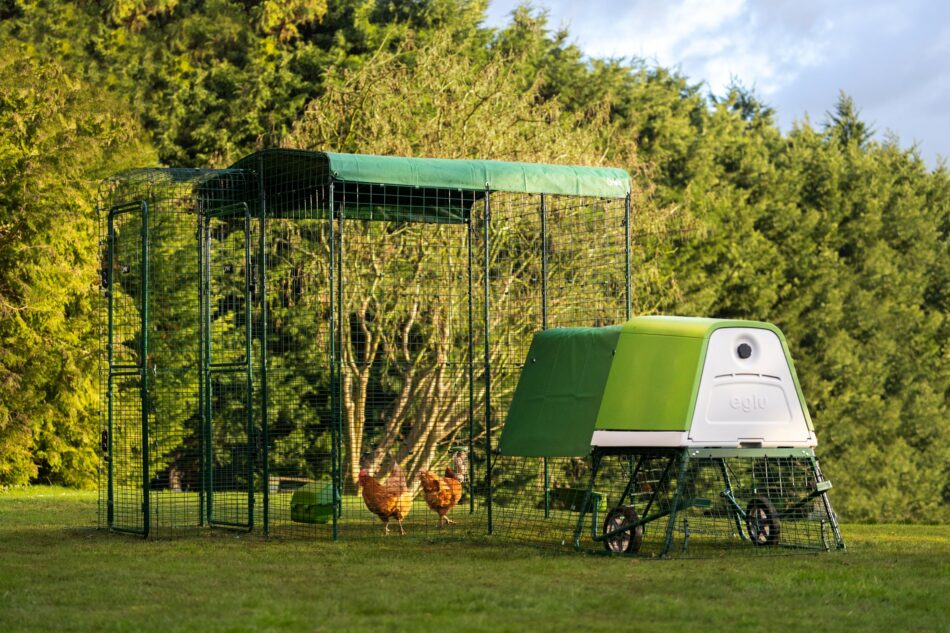
Looking for a beginner chicken coop? The best chicken coop for beginners are those that can grow along with flocks and their keepers – making it the first and last chicken coop you’ll need to buy. There’s a lot hinging on your hens’ home: their health, safety, and comfort. You’ll also want a coop that is easy and quick for you to clean, and is enjoyable to use. Omlet has the coops to check all of those boxes – and more.
The best Omlet chicken coops for beginners
The best chicken coops grow with their flocks and keepers’ level of experience. And, the best beginner chicken coops are easy to use from the start, but also functional and practical enough for even the most advanced chicken keeper.
We’ve made keeping chickens easy for all ages and stages of flock-raisers. Omlet’s line of Eglu chicken coops not only provide superior safety and comfort to the hens they house, but also allow owners to spend less time cleaning and worrying and more time enjoying their flock.
All of our coops are:
- Easy to build
- Simple to clean
- Predator resistant
- Have the ability to be mobile with the addition of our wheels and handles kit
- Are twin-wall insulated, keeping your flock comfortable all year round
Choosing your chicken coop depends on your space and how big of a flock you intend to keep. Once you’ve got an idea of where you want to place your coop and how many hens you want to have, you’re ready to find the coop that best fits your needs.
Types of chicken coops
There are a few choices to make when it comes to buying a beginner chicken coop. Some popular options are:
Each type of chicken coop has their own advantages, so you’ll need to decide which option best fits your lifestyle and space. For example, mobile chicken coops allow you to move your flock around your garden whenever you’d like. This lets your hens peck new grass and prevents a permanent spot from being worn into your lawn. Large chicken coops can house up to 10 small breed hens comfortably, and can also be converted into chicken tractors. Ground-level coops are best for chickens that don’t have a strong roosting drive, or for gardens subject to height restrictions.
Wood vs plastic chicken coops
Above all, the best chicken coop for beginners is a plastic chicken coop. There are many reasons why plastic chicken coops are better than wooden chicken coops, as plastic is:
- Easier to clean
- Mite-resistant
- Rot-proof
- Better insulated
- Draft-free
- Easier to assemble
Purchase a plastic chicken coop at the beginning of your chicken-keeping journey, and it will serve you and your flock for years to come.
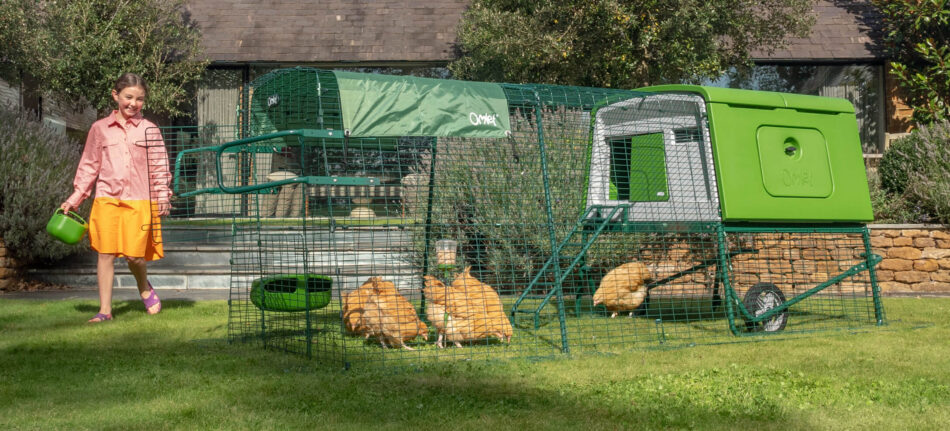
DIY vs ready-made chicken coops
Deciding whether to buy or build your first chicken coop? Building a proper chicken coop from scratch is hard – especially if you’re new to chickens. Hens have essentials when it comes to their home, and it’s hard for DIY plans to get them right. Most DIY plans look aesthetically pleasing, but leave much to be desired in functionality, safety, and practicality.
Omlet coops come as a kit to be assembled and have everything you need to get started with your flock right away. Our designs have been keeping hens healthy and happy for over a decade – so there’s no guesswork for you.
Choosing the perfect size coop for your flock
There’s a term that all chicken keepers will experience at some point: chicken math.
It’s used to describe the phenomenon of bringing home more chickens than you originally intended. This can occur right off the bat, or take a few months to set in, but at some point, most (if not all) chicken keepers crave more chickens.
That being said, it’s always best to get the biggest coop you can for your space and budget. Chickens thrive when as much space as possible is available to them, and extra space allows room for the inevitable chicken math conundrum.
What needs to be in your new chicken coop
A good chicken coop keeps hens comfortable, safe, and shielded from the elements – but a great chicken coop offers entertainment and enrichment as well. Chickens get bored if they don’t have enough stimulation, which can lead to behavioural and health issues. Be sure to offer a variety of things to keep your flock busy when they’re in their coop’s attached run. To bust boredom, try offering:
The more space and activities your hens have, the happier and healthier they’ll be. Some other ideas to keep boredom at bay include: serving fresh veggies in a Caddi Chicken Treat Holder, socialising with your flock, or moving a mobile chicken coop to fresh pecking grounds.
Top chicken coop care tips for new keepers
New chicken keepers should keep the following in mind when taking care of their chicken coops:
- Clean out your chickens’ coop daily to keep it fresh and to keep your hens’ in good health
- Use an odour-absorbing bedding such as pine pellets or shavings
- At least once a week, remove the roosting rack and droppings tray from your coop to pressure wash, or scrub with soap and water
- Collect eggs daily to help prevent broody hens and visits from predators
Keeping your chicken coop clean is one of the best ways to ensure that your hens are in a healthy atmosphere. Like most birds, chickens keep themselves clean through preening and dust bathing – but it’s up to their owners to keep up with their housekeeping.
Choosing a run your flock will love
Companion pieces to most chicken coops are chicken runs. Even if you want your hens to have access to most of your garden, there will inevitably be times that you’ll want to keep them penned up in a run. Large chicken runs give flocks that free-range feeling, without the hazards.
The best option for large spaces is a walk in chicken run. Not only does it maximize your chickens’ space, but it allows you to walk with your flock and get closer than ever to your hens. Omlet’s walk in chicken runs can also be extended at any time to accommodate a growing flock. Covers for walk in chicken runs can be added to give your flock shade from the sun or a barrier from snow, rain, and wind.
Other considerations when choosing your coop
Once you’ve researched and chosen the type of coop that best fits your lifestyle, you’ll also need to consider: chicken predators, the changing seasons, and zoning laws that may be applicable to you.
Predators
Omlet coops are designed to protect against chicken predators. The types of predators vary depending on your location, and you can bet that at some point they will come after your hens. Common chicken predators include:
- Foxes
- Badgers
- Neighbourhood cats and dogs
Adding an automatic chicken coop door to your chickens’ coop adds an extra layer of protection against predators. The Autodoor ensures that your flock is safely closed into their coop each night, and the horizontal opening mechanism makes it extremely difficult for predators to pry open.
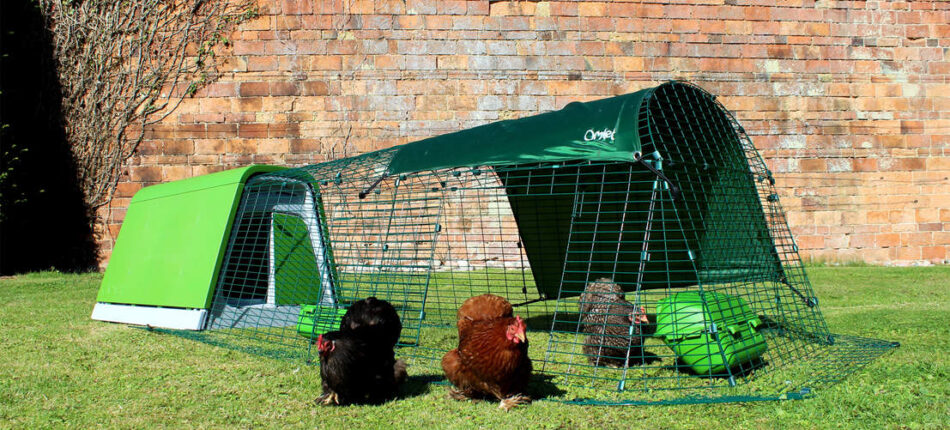
Seasons
Chickens are amazingly resilient, being built for life outdoors. However, not all breeds fare well in extreme temperatures. That’s why it’s so important to choose breeds that are suited to your location’s climate. Cold hardy breeds typically don’t fare well in the heat, while heat-tolerant breeds may struggle in the bitter cold. Ageing hens may also not weather the changing seasons as they once did, and some minor coop modifications can go a long way in helping them through more extreme temperatures.
For the winter, an extreme temperature jacket can be added to your chickens’ coop as an extra layer of insulation. Weather protection for attached chicken runs in the form of tarps and covers can also be added to keep snow, rain, and wind off of your hens.
The same tarps and covers can also be used for hot weather conditions by providing shade on scorching days. Hens often do well in warm weather as long as they have adequate shade and water.
Keeping chickens for the first time
Getting chickens for the first time is an exciting experience. But don’t forget that preparation goes a long way when getting ready to bring your flock home. Make sure you have the time, space, and supplies for your hens before committing to being a flock’s forever home. Some additional things to consider when keeping chickens:
- A safe, comfortable chicken coop
- Chicken run
- Perches
- Food
- Feeders and waterers
Make sure all of your equipment is assembled, and familiarise yourself with it before introducing your flock. You may find yourself wanting to make minor adjustments such as moving feeders and waterers or perches around, but the majority of your chickens’ set-up should be well established by the time your hens come home.
Your first and last chicken coop with Omlet
Choosing your chicken coop is a commitment, but when the creators of the coop are as committed to chickens and their keepers as Omlet, you’re sure to have the best experience possible. And, don’t forget to have fun with your flock. Accessories for your chickens take flock-keeping to the next level, and chicken treats help you quickly bond with your hens.
When you choose Omlet for your chickens’ coop and accessories, you’re not just purchasing your first coop – it’s the only coop you’ll ever have to buy. Unless of course you fall victim to chicken math and need more chicken coops. Don’t say we didn’t warn you!
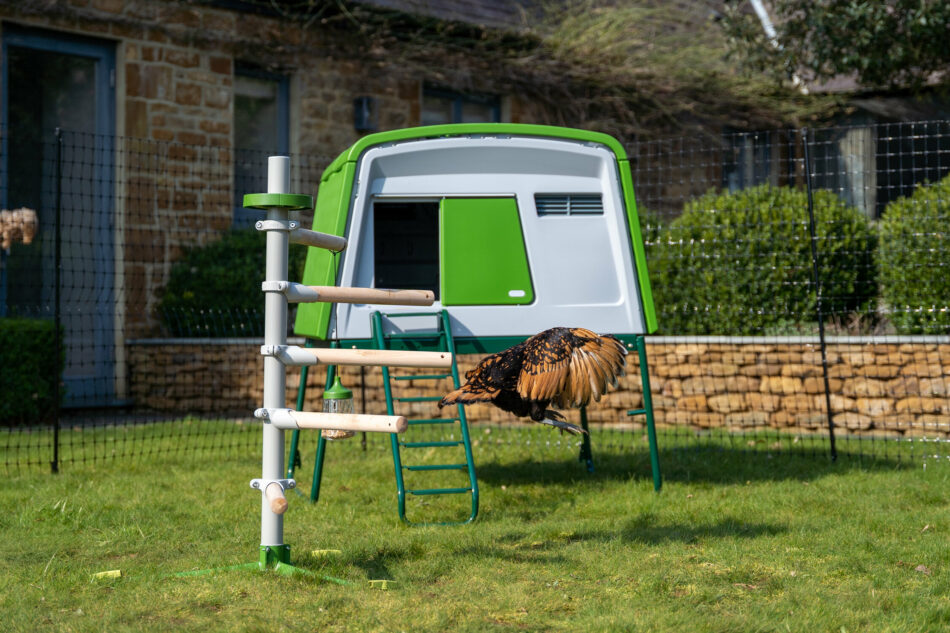
This entry was posted in Chickens
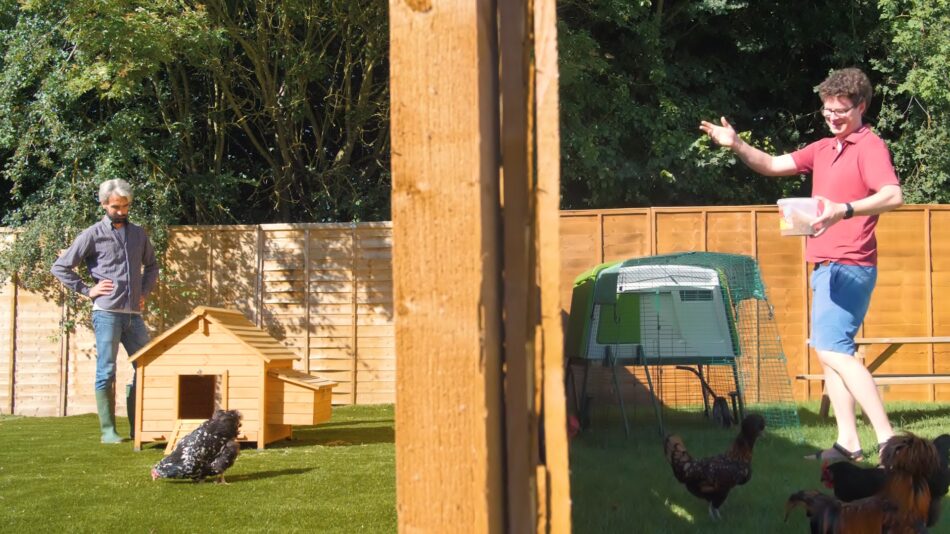
Worried about your chicken coop rotting? It’s a valid concern that all chicken keepers have. Chicken coops are out in the elements, and can take a beating from the weather and predators. Still, chicken keepers rely on their structural integrity to keep their flocks safe – so what happens when a coop starts to rot?
Thankfully, not all chicken coops rot. Wooden coops all eventually succumb to their exposure to the environment, but there’s an alternative option. We invite you to consider: Omlet’s plastic chicken coops.
Why do wooden chicken coops rot?
Wooden chicken coops, by nature, break down over time. No matter how “weather-treated” boards, planks, and roofs may be, they will eventually decompose when exposed to the relentless elements. This is especially true in areas that receive a lot of humidity and severe weather. A constant battering from rain storms, followed by intense sunshine will leach out the weather protectants that lumber may be treated with. Wind and rain will also loosen or warp shingles on chicken coops, making coops drafty and wet. Once the weather has stripped wood of its protectants, moisture sets in, and the wood begins its rotting process.
Wood that stays damp rots the fastest. Wet wood swells and expands, which allows for more moisture to make its way in. And, when exposed to the sun, swollen wood begins to contract when it dries. Through this process of swelling and contracting, wooden chicken coops begin to lose their shape as the boards or planks warp. You may notice bowed or split wooden components on your chicken coop as a result, which will eventually break or collapse. Different types of wood experience this process at varying speeds, but most commercially bought wooden chicken coops are made from lower-quality wood with a shorter lifespan.
Once the wood of a chicken coop begins to rot, any affected boards will need to be replaced. It’s important to address any rotten pieces of a chicken coop immediately to avoid adverse health effects on your chickens. Rotten wood attracts mites and other parasites that will plague your hens, and mould or mildew is often present in damp wood. These fungi can cause respiratory problems in your chickens, and creates unsanitary conditions for both you and your flock.
How to prevent your chicken coop from rotting
Oftentimes it’s easier to build or purchase a new chicken coop from scratch than to renovate a rotten one. Repairing a rotten chicken coop is costly and time-consuming, and will likely need to be repeated throughout the lifetime of a wooden coop. There are preventative measures you can take to maintain a wooden coop to help improve its longevity, but these too take effort and resources.
Repainting, staining, or weather-treating a wooden chicken coop
To help prevent wood rot, wooden chicken coops can be repainted, stained, or weather-treated regularly – usually on an annual basis. Take great care to select products that are non-toxic to chickens, and allow for ample drying time between coats before allowing your hens back into their house. Natural products such as tung oil can be applied to wooden chicken coops to make them water-resistant, but 100% pure tung oil can be costly.
Keep your coop covered
Another method to help prevent wood rot is to keep your chickens’ coop covered. This could be through the use of a tarp, inside of a structure such as a shed or a barn, or by building a structure over the top. It may seem a bit redundant to cover a chicken coop that is meant to protect your flock from the elements, but shielding a wooden coop from sun and moisture can help preserve its components. This isn’t the most convenient option, and application of water-resistant products will still be needed on occasion to protect the exterior of your coop.
Forgo a wooden coop
By far the easiest option to avoid having to fix a rotten chicken coop is to purchase a plastic chicken coop. Omlet’s Eglu Cube chicken coop is made of heavy-duty plastic that’s weather and waterproof, so there’s no concern over rotting components. Truly a zero-maintenance solution, the Eglu Cube is ready to house a flock of up to 10 small breed hens from the time it’s assembled. Omlet’s design is meant to last a lifetime, which means no breaking down or rotting, and no application of preservatives is required to keep your Eglu Cube sanitary and functional.
Why do plastic coops not rot?
The short answer as to why plastic outlasts wood is: because plastic does not exist in nature, naturally occurring organisms are not effective at breaking it down. Wood exists in nature, so there are bacteria and other living organisms that are equipped to dispose of it. Plastic, on the other hand, has no “natural” foes.
Plastic chicken coops do not rot or lose their shape in the elements and do not require routine maintenance. They’re also much easier to clean, offer a more sanitary environment, and are able to be moved with ease compared to their wooden counterparts.
How to maintain a plastic coop
All Omlet products are designed to last, but you’ll still want to check in on your chickens’ coop routinely for any signs of wear and tear. Usually, any doors or parts that are not aligning properly are the result of the soil beneath the coop shifting, and can easily be corrected by moving the coop by a few inches as needed. Chicken run clips may also come loose during these shifts, and should be checked regularly.
Aside from checking your coop for shifting, you’ll also want to clean your coop regularly to keep it fresh. Even deep cleaning the Eglu Cube takes mere minutes, as compared to several hours of cleaning a wooden chicken coop. A pressure washer or high-powered water hose makes the process go even faster. Simply remove the droppings tray and roosting rack, spray clean, and wipe dry.
Compared to wooden chicken coops, maintaining the Eglu Cube saves countless hours each year. And, a coop that’s so easy to clean and maintain creates a much more sanitary environment for your hens, which cuts down on illness and discomfort brought about by the weather. Keeping chickens has never been easier or more enjoyable than with an Omlet coop.
Omlet and your chickens’ perfect home
A rotting chicken coop is a frustration for chicken keepers that we sought to put an end to. The result is our line of high-quality chicken coops that stand the test of time. Combine your Eglu Cube with a Walk In Chicken Run for the ultimate chicken-keeping experience. And, with accessories such as the PoleTree Customisable Chicken Perch or Caddi Chicken Treat Holder, you’ll be able to foster and enjoy watching your hens fulfil their natural behaviours.
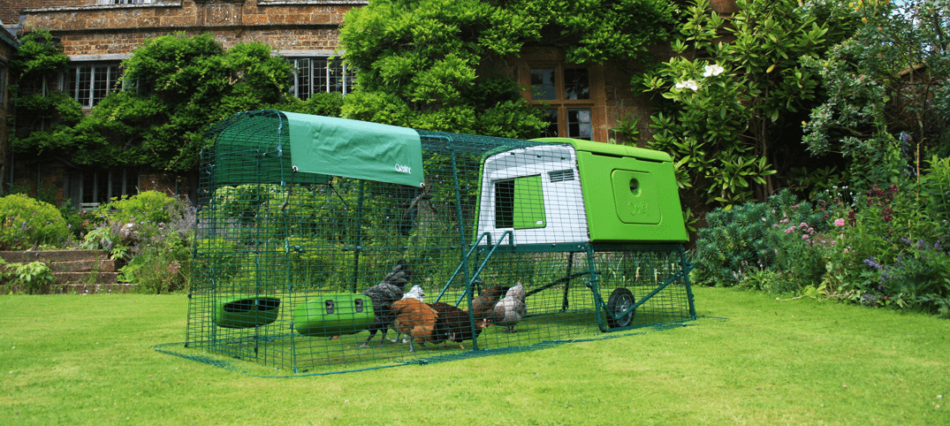
This entry was posted in Chickens
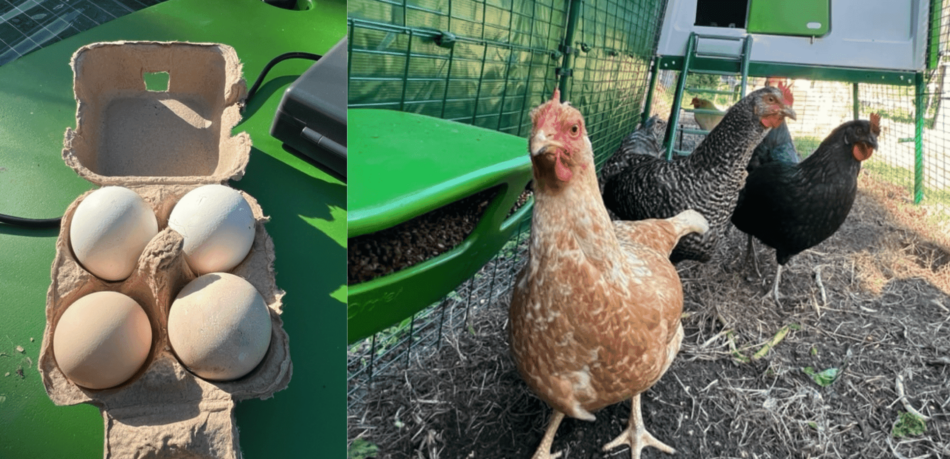
Last month we spoke to Mark Chandlers who told us all about his wonderfully ingenious use of our Walk In Chicken Run, which saved his plants from predators. We caught up with our happy customer again, who’s decided to give our Eglu Cube Chicken Coop a go…only this time, for chicken keeping! Here’s what Mark and his four hens Bella, Greta, Evangeline and Mrs Wilkie thought about their brand new home.
I love a company that thanks you for purchasing their product.
Thank you for purchasing a Flarnhoff fingernail waxer.
Thank you for your purchase of this Boing B-52 Strategic Nuclear Bomber. For 15% off your next purchase, leave a review on our website.
And the latest to wish me well on my journey was the good folk from Omlet when I began assembling my new Eglu Cube. I sat down and carefully read the instructions. And then I carefully fell asleep. I remembered why I was rubbish at school. I have the attention span of a Gudgeon. Much better watching someone else do it, so I went online to watch the YouTube clip of someone building an Eglu, and it was brilliant.
Actually, it’s not hard to build really. I finished the job by myself in an hour and a half. Two people would be handy but mainly so you have someone to chat to. All you need is a Phillips head screwdriver, a song in your heart and a modicum of common sense. For my Cube, I bought the Automatic Chicken Coop Door (easy to install and worked the first time) and a three-metre run. I didn’t buy the wheel kit because eventually the Cube will be built into a larger Walk In Chicken Run.
What Omlet has done here that is so clever is to make one of the more challenging parts of keeping chickens really easy. That is, building their home. The rest isn’t difficult but does need some effort and research. Where do I buy my chickens from? What sort of chickens do I buy and what do I feed them? While there are around two hundred answers to each of those questions, I honestly believe the best answer to housing backyard chickens is the Omlet system based around the Eglu Cube.
Once built, I was off to buy some chickens. That afternoon Bella, Greta, Evangeline and Mrs Wilkie were safely ensconced in their new home. So a few things you need to know about keeping chooks:
- Everyone has a story about keeping chickens and how their flock met an untimely, often grizzly, end. Why people feel compelled to tell you this, I have no idea. I wonder if they do the same thing when their friends have a baby.
- There are four basic personalities in every group of chickens. The escapee artist, the greedy one, the nervous one and the one everyone loves.
- Chickens love to be let out for a roam but while three of the four will just putter about, the escape artist will take off in a straight line without ever looking back. You’ll usually find it in the next town somewhere living under an assumed name.
- Chickens love company.
- Sometimes, for no apparent reason, they’ll start a cackle-a-thon as if they’re in danger. So you go out expecting to see a goanna (unlikely if you’re in the UK) or a Wedge-tailed eagle (Australian readers only) or a Carpet python (again, unlikely) only to find them arguing over a worm. Although I’m starting to suspect it’s because of item 4.
It’s a few weeks in now and we’re getting fresh eggs every day while every other day we’re retrieving Evangeline from the next suburb. Although to be clear, she’s never hoofed it from the enclosure, only when the group are free ranging. Also, I’m now getting what was a trickle at first and now a steady stream of people visiting to check out the Eglu. “Hi, yes it’s called an Eglu. Yes, it is very clever. Oh, I agree, the chickens do look happy. Oh, you kept chickens once yourself. They were slaughtered by the Saracens you say. Fancy that! You don’t see many Saracens here in Australia, what are the chances? Cleaved right in half, well I never”.
The Eglu Cube is easy to order, easy to build, versatile, functional and looks stylish. Everything has been cleverly thought through and is exceptionally well built. And there’s no better example of that than the food and water containers. On social media groups specialising in keeping backyard poultry, 65% of the questions are about which food or water bowl is best. Answers range from the ludicrously simple, such as an ice cream container, through to all sorts of Heath Robinson contraptions. The Omlet food and water containers have already endured heat, rain, hail, bush turkeys, wind and splaw-footed visitors steeping on them. And they have always, and still, work perfectly.
This entry was posted in Chickens
Did you know that Omlet’s Eglu Chicken Coops have survived bear attacks, fallen trees, and even tornadoes? We’ve seen the Eglu Cube save chickens and remain unaffected by the harshest of conditions on countless occasions – our products are built to last, after all. But how good is the Walk In Chicken Run at protecting veggie crops from pesky predators? Plant enthusiast and happy customer Mark put this question to the test. Find out how he came to discover his secret tool for keeping his garden crop safe from the “enemy”…
Australia, land of a million things that want to kill you, or at least eat your veggie crop. In 1932 the Australian army went to war with the emus and lost. When I lived in England for a year, way back, the only dangerous animal I encountered was a hedgehog and that was because I tripped over it on my way home from the pub. I remember it looking at me rather pityingly.
Know thy enemy:
Possums: There are ten different types of possums native to Brisbane. But the one I struggle with is the Common Brushtail Possum. They’re not called that because of their abundance but rather their lack of taste, education, and good manners. Brushtail possums hang around local shopping centres in groups, smoking and listening to Hip-Hop music. At night they do hits on local gardens and steal cars.
Sulphur Crested Cockatoos: These things are huge and prune trees with their powerful secateurs-like beaks just for fun. A flock can decimate a fully-grown tree in an afternoon. They usually gather on street corners, shaking down tourists and pensioners for change and travel cards. But they are most dangerous when they decide your crop of sweet corn looks promising.
Corellas: Smaller and more polite than the Sulphur Crested, in small numbers these birds are hilarious. They will gather on rooftops and slide down for fun. But in large numbers, they become a ravenous hoard. They descend on towns in the state of NSW in the tens of thousands and eat everything, including windscreen wiper blades, the windscreen seals and telephone cables.
Bush Turkeys: America got magnificent big turkeys that are large and good to eat. We got tough, wiry clumps of feathers and sinew on legs that spend their day scraping all the compost out of your garden and across the road to your neighbour’s yard.
Flying Foxes: I came home from work one evening to find my English flatmates locked in their rooms. Turns out, they’d been enjoying a cool Brisbane autumn evening when “These giant flying things like something out of Lord of the Rings” started flying over. “Oh, you mean the flying foxes,” I said. “You knew about these things?! Why didn’t you warn us?” they cried. Fruit bats are in fact lovely and don’t want to kill you at all. But the Hendra virus they carry and can transmit does want to kill you, and the bats eat any fruit they can latch onto.
The battle begins
Early attempts to save my veggie and fruit crops were a potpourri of lousy advice, expensive gizmos, spray-on homemade potions, idiotic gadgets and some straight-out stupid ideas. Once, I even purchased a scary-looking plastic owl to put up in the garden. The stupidity of this idea is breathtaking. First up, we have Tawny Frogmouths and Kookaburras, and nothing is scared of them. Kookaburras eat snakes for goodness sake! Second, the silly thing looked more like Tommy Hancock than an owl. And finally, it was made of plastic so it didn’t do anything. I knew that idea had bottomed out when I awoke one morning to find its severed head next to me in bed with a note from the possums.
In search of a solution
I looked everywhere for an answer. On the recommendation of my local nursery, I covered all my garden beds in white mesh netting. That afternoon the Police called because from the air it spelt out H.E.L.P. I tried a greenhouse but greenhouses in the subtropics end up as a breeding ground for super weeds and bugs so big they get jobs loading trucks at the markets. I even stopped growing veggies and planted avocado trees with an understory of spiky finger lime bushes to stop the possums. Turns out the possums use the finger limes to scratch themselves and every creature in the world eats avocados. But then, I was at my local hardware megastore one day when I spotted a pet enclosure. It was flimsy, and not very big, and not very adaptable, but maybe that might work.
A few broken eggs:
The internet is a wonderful thing and now, with the pet run idea in mind, I began searching. The usual crazy stuff appeared during my searches. Sore Knees? Eat This!, The New Way to Eat Toast, Omlet, Why Drive When You Can Swim? A Bear Walked Into A Bar, You’ll Never Guess What Happened Next. I kept searching, nothing looked suitable. Omlet.
Reviews looked bad. Omlet. Some were too expensive, some looked too flimsy. Omlet. Why does this Omlet thing keep appearing? Better have a look.
The answer
Turns out Omlet have a pet run, sturdy, flexible, good-looking, easy to install, interchangeable and versatile. So what if, instead of keeping the animals in as they suggest, I buy an Omlet pet run to keep the animals out? Could that work? Why don’t I buy a small one and see?
The purchase: online and very, very easy
Delivery: Lots of boxes, well packaged and clearly labelled so you knew what was in each box.
Construction: Here’s where things veered off course for me. Not Omlet’s fault because I had to build the enclosure around something, not build it to put something in. And that proved challenging. The instructions are clear and easy to follow and there are some helpful tutorials online. But I wish I’d sat down and laid out all the parts in order before tearing into it like a crazed tram conductor. I would recommend laying everything out before you start building. Way easier. But despite my backyard being strewn with Omlet, parts various, it went together surprisingly easily. I built it by myself although two people would have sped things up. And my best piece of advice…learn to love the clip.
The moment.
I knew I was on a winner the moment I finally installed the gates. Often the weak point of a garden building, the Omlet gates went straight in easily, worked perfectly from the get-go and still work perfectly today.
Versatility
Because my Omlet build was somewhat off-piste, there were some things I did differently. For example, I didn’t need the anti-dig surround. So I turned most of those pieces into shelves. Won’t take much weight but a handy spot to leave a few tools. Some of the straight pieces I used to extend the end wall to make a trellis. Mind you I saw a possum walk past me at the bus stop the other day carrying a shovel he’d bought from the hardware, so I might need that surround after all.
And did it work?
Yes. The Omlet run has kept everything out. I left some chilli bushes I’d potted up out on my workbench overnight and the next morning I found them mostly eaten. The ones inside are as healthy as. My plants still get grasshoppers and snails. The Omlet can’t stop them. But my veggies now only have a few bugs and insects to deal with, not a continuous cavalcade of marauding wildlife. And every day I discover new tricks. Tomato stakes are easily installed by putting them in the garden beds and poking the top out through the mesh in the roof. No need to bash them all the way in, the mesh holds them steady. And on really hot, sunny days, of which we have many, I can drape over a small tarp to keep the midday sun at bay.
Would I recommend Omlet?
Well, I’ve just bought a 7-metre pet run that will be half chicken coop, half veggie garden. So yes, I would recommend it. The Walk In Chicken Run, used how I used it as a garden protector, exceeded my expectations, the product is cleverly designed, of high quality, well built and easy to use. Best of all I found Omlet very easy and helpful to deal with. I needed to ask a few questions for my next project and they were answered promptly and were exactly what I needed to know.
Thanks, Omlet.
Have you got an interesting story about your Omlet product? Email blog@omlet.com.au to tell us more.
This entry was posted in Chickens

Did you know that you can keep chickens in the city? It’s true – you can have your own slice of farm life right in your backyard. There are a few special considerations when caring for chickens in an urban setting, but with a solid strategy and quality flock essentials, you’ll be able to enjoy fresh eggs and the unique experience of owning chickens.
Do you have enough time to raise chickens?
After you’ve gotten permission or verified there are no restrictions for having chickens in your backyard, it’s time to make a plan! First and foremost, you’ll need to evaluate how much time you have to dedicate to a backyard flock. Will you be home daily to collect eggs and check in on your chickens? Do you travel a lot? Would someone be willing to tend to your flock in your absence?
As far as pets go, chickens are relatively low-maintenance. Chickens don’t require daily interaction from their humans like other pets, but they do need basic provisions. If they have a secure chicken coop and run, their food can be left out and refilled as needed, along with their water. An easy-to-clean chicken coop is a huge time-saver when it comes to refreshing your hens’ home. Chicken coops in the city should be cleaned daily to minimize the presence of odours and insects.
Laying hens should have their eggs collected daily if possible to prevent attracting nest-thieving predators. When collecting eggs, take the time to do a brief check-in with your hens to make sure everyone is healthy and happy. Inspecting your hens’ eggs can also give you a good idea of their overall health.
You’ll need to have a reliable chicken-sitter for when you go out of town. Most people from the city would love the opportunity to care for chickens, but may be unfamiliar with hens. Provide detailed instructions and allow ample time for your chicken-sitter to come by and watch how you tend to your flock before leaving.
Consideration for neighbours
Once you’ve determined how and where you can house your hens, and decided that the time commitment fits with your lifestyle, it’s time to prepare your backyard for your flock. Do you want a mobile chicken coop that can be repositioned, or the more permanent placement of a coop with a walk in run chicken run?
Keep in mind that while chickens themselves have little to no odor to the human nose, their droppings do. Be considerate when choosing the location of your chickens’ coop – toward both yourself and your neighbours. Daily coop cleanings will cut down on smells and the presence of flies, but you should place your hens’ house an appropriate distance from human dwellings.
Most hens won’t make much noise, but they can stir up a ruckus when something is amiss in their surroundings, or when they have laid an egg. The majority of chicken sounds and their meanings are quiet daily interactions with each other and their surroundings. However, some hens are capable of making noises that may come across as other-worldly to your neighbours, so it’s a good idea to explain your new backyard inhabitants to them ahead of time! And, even if you’re not restricted from owning roosters, be aware that they crow at all hours – not just at dawn. In fact, many roosters will crow in the middle of the night. If you’re in close proximity to neighbouring houses, it’s best to forgo owning a rooster.
Urban predators
Urban settings are not immune to the presence of predators that have a taste for chickens. While most backyards in the city won’t experience larger predator attacks, there are still several animals that may try to infiltrate your chickens’ coop or run. Urban predators include:
- Rats
- Snakes
- Hawks
- Foxes
- Neighbourhood cats or dogs
The Eglu Cube Chicken Coop is a predator-resistant option for backyard flock keepers. The unique coop door mechanism makes it difficult for animals to pry open during the night, and the locking egg access and rear doors help keep unwanted visitors out.
An Omlet Walk In Chicken Run provides safety measures from the ground up. Anti-dig skirting comes standard on all Omlet chicken runs to help prevent tunnelling in from the outside, and mesh roof panels keep aerial predators at bay.
If your space doesn’t allow for a walk in run, an automatic chicken coop door can be installed on your Eglu Cube or other chicken coop to ensure your hens are tucked away safely each night. Not only can you automate your chickens’ schedule with the Autodoor, but you can add an additional layer of security between your flock and potential threats. The Autodoor opens horizontally on a spiralling metal mechanism, making it extremely difficult for animals to pry open.
Noise of the city
Your chickens may be temporarily upset by the noises created by traffic or pedestrians. Since chickens are adaptable, they’ll grow accustomed to the noise over time, but if possible position your chickens’ coop behind a good sound barrier. This could be your home, a privacy fence, or another solid structure.
If you’re introducing farm-raised hens to an urban setting, the transition may be more stressful than chicks raised in your environment. Consider placing chicken run covers on the sides of your flock’s run to give them a reprieve from visual stimulation while they process the noises of their new surroundings.
How Omlet can support city chicken keeping
Chickens are happy just about anywhere, but at Omlet, we want them to be able to foster their natural behaviours no matter where they live. All of our chicken products are designed to enrich your flock’s environment – no matter how big or small. Chicken peck toys, the Freestanding Chicken Perch and Chicken Swing are just some of the products we’ve invented to keep your hens healthy and happy in their home. With a chicken coop and run to fit any size backyard, you’ll find that our expertly designed products will ensure success when keeping chickens in the city.
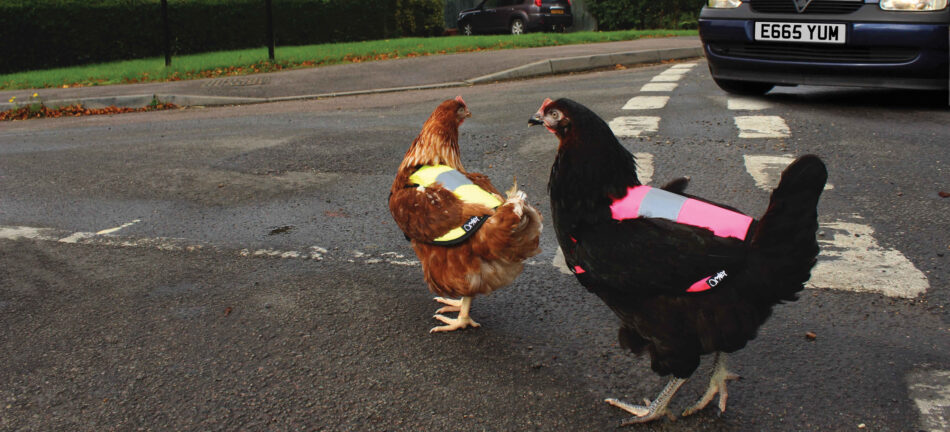
This entry was posted in Chickens
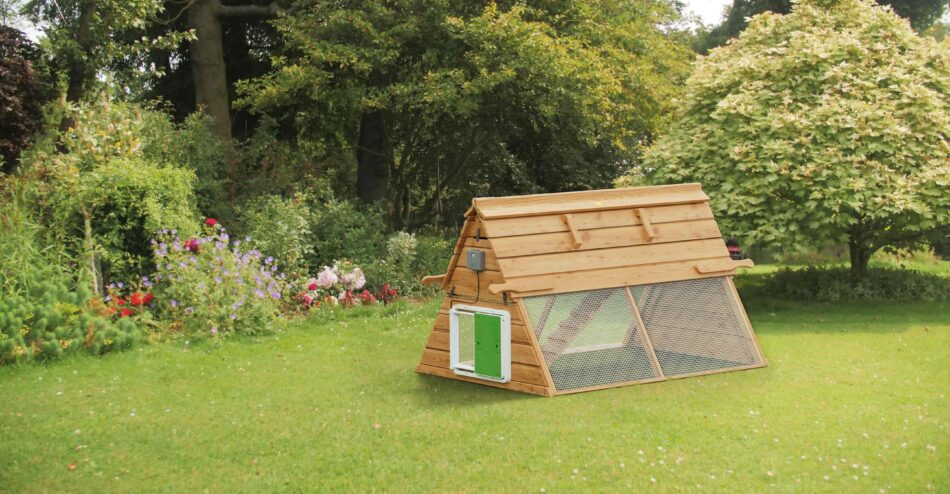
Do you have a wooden chicken coop in need of some home improvements? All wooden coops need routine maintenance and refurbishing – sometimes on a yearly basis. But how long should you expect a wooden chicken coop to last?
Chickens have been kept in various structures throughout history: barns, coops, even baskets! But over time coops have become the most popular hen-housing option, with wood being the most common material used for construction. Wood is easy to work with and relatively inexpensive, which makes it a favorite among DIY enthusiasts and coop supply companies alike. But the downside to wood is that it does not withstand the test of time and will inevitably require upkeep over the years.
When considering whether to make updates to a wooden chicken coop or to start fresh with a new design, several factors should be considered: Do you like the idea of a coop that can be easily moved? Easily cleaned? Resistant to mites, moisture buildup, and predators? If so, changing from a wooden coop to a plastic chicken coop will be a better option!
“If it ain’t broke, don’t fix it.”
This proverb holds true for many things, but wooden chicken coops are not among them! Even if your chickens’ wooden coop seems structurally sound, attention to detail is crucial to the health and wellbeing of your hens. If you notice the following issues with your wooden coop, it’s time to make repairs:
- Moisture buildup, or the presence of mold or mildew
- Sagging boards, gaps, or holes that cause drafts
- Rotting wood
It’s important to remove any affected boards and replace them with treated wood. If the siding or roof of the coop is involved, you’ll need to cut out the affected sections. Rotting wood is not only a hazard to your chickens, it’s also breeding grounds for parasites and bacteria or fungus. Remove any questionable sections of your chickens’ coop as soon as possible!
Small repairs may not be time consuming, but replacing larger sections of a wooden chicken coop requires both time and resources. You’ll also need to evaluate if the affected sections are going to compromise the structural integrity of the rest of the coop. If so, it may be time for a new chicken coop.
Enter: plastic chicken coops
The alternative to traditional wooden coops is the Eglu Cube Chicken Coop. Made from sturdy plastic, these chicken coops are easy to clean, move, are predator resistant, and require zero maintenance. The twin-wall insulation keeps cold and heat out during their respective seasons, while maintaining just the right amount of ventilation to create healthy air circulation. Additionally, these plastic coops can be pressure washed and thoroughly disinfected, creating a much healthier environment for your hens.
The Eglu Cube Chicken Coop never has to be painted, re-roofed, or weather treated like traditional wooden chicken coops – saving countless hours and dollars. It’s easy to assemble, and once erected, this heavy-duty plastic chicken coop is easy to move around the yard with the help of its integrated wheels and handles!
Are your hens happy in their wooden coop? If their coop is drafty, poorly insulated, or harboring mold or parasites, it’s definitely time to make a change!
Eglus for egg-layers
Aside from scoring bonus points for “being different,” Eglu chicken coops also earn high marks among chickens! Providing a cozy space, the Eglu’s insulating design utilizes your hens’ body heat to keep them warm even on the coldest nights. The Eglu Cube and Eglu Go Up Chicken Coops both offer the raised roosting space that chickens seek out at bedtime. Add in an automatic chicken coop door and you’ll be sure your hens are tucked in tight every night!
Plastic surfaces are inhospitable for parasites such as mites that so often plague chickens. And with the unique design of the Eglu, just the right amount of air circulation takes place without letting in drafts. No moisture buildup, mildew, or mold in a well ventilated coop makes for healthy and happy hens.
No more small roosting bars for your birds to balance on overnight – the Eglu Cube has an entire roosting rack complete with a droppings tray that can be easily removed and cleaned. Your hens will appreciate the break their toes receive when they’re able to get as comfy as they please at bedtime!
Eglus for egg-aficionados
Loved by chickens, but adored by their keepers – Eglu chicken coops are an all-in-one solution for flock-tending! Plastic coops don’t require any routine maintenance, and all of our Eglu chicken coops have removable parts for quick, but thorough cleanings. Spray them down with a hose or pressure washer, and finish with a quick spray of chicken-safe disinfectant for a fresh coop in minutes!
Not sure if you love where you decided to put your chickens’ coop? With integrated handles and wheels, the Eglu Cube can be moved with ease by one person! A chicken tractor that doesn’t require helping hands to move is always a win in the chicken-keepers book.
One and done – once an Eglu is assembled, that’s it! No maintenance, painting, removing rotten pieces, or making modifications. From the time the last piece goes into place, an Eglu is ready for hens for many years to come.
Eglus are built for winter
Not just a clever play on words, the Eglu’s unique design offers your hens optimal warmth throughout the cold months. Similar to double-paned windows, the twin-layer walls offer superior insulation by keeping your hens’ body heat in and the cold air out. A pocket of air surrounds the entire Eglu while still maintaining proper ventilation. The result? A toasty warm, well ventilated chicken coop!
In the debate of “Eglu Cube vs Wooden Chicken Coop – Which Will Stay Warmer?”, the Eglu Cube is the clear winner. Wood is too porous to truly insulate, and while spray or roll-insulation can be utilized in wooden coops, the process of layering such material between two sections of wood makes the coop much too heavy to move. Air as an insulator is much lighter and more effective for trapping heat.
No added insulation is needed with an Eglu chicken coop, unless your area has sustained, frigid temperatures. Optional extreme weather jackets can be added as a protective layer in climates that experience severe winter weather. All you need to do to ensure your hens stay warm in their Eglu during winter nights is close them in – the Eglu and your hens’ body heat will do the rest!
Wooden coop vs plastic coop care and upkeep
It’s important to remember that all wooden coops will require ongoing repairs and upkeep. Common wooden coop maintenance includes:
- Replacing weather-worn or rotten boards
- Hosing down or washing, allowing several hours for the wood to dry
- Reapplying paint or weather treatment (must be chicken-safe!)
- Replacing shingles on roofs
- Patching holes created by insects
- Applying diatomaceous earth or other chicken-safe pest control products to the interior and exterior perimeter
In contrast, plastic chicken coops such as the Eglu Cube don’t require any maintenance over the years. Once assembled, they’re ready to keep chickens safe and healthy for years to come! Pressure washing or hosing down the removable interior pieces and changing the bedding in the nesting area and in the droppings tray is the extent of maintenance for plastic chicken coops.
Complete the setup
We have an entire line of chicken products dedicated to keeping your chickens healthy and happy, while ensuring that caring for your flock is easy and enjoyable. Some of the companion products that integrate seamlessly with an Eglu chicken coop include:
Not only will you have peace of mind knowing that these products will not require routine maintenance, but also in the confidence that your hens are housed in meticulously designed coops and runs that will keep them safe and feeling their best!
Chicken chores? We don’t think so!
At Omlet, we invent products that turn chores into enjoyable activities for you and your entire family. Our chicken products make caring for flocks easier than ever – and less time maintaining or cleaning your chickens’ area means more time to enjoy their company! Designed with new and seasoned chicken keepers in mind, our Eglu chicken coops check the list for all backyard flocks.
Ready to make the switch from a wooden chicken coop to a zero-maintenance plastic coop? Let us know, and our team of experts will help you pick out the perfect setup for your flock!
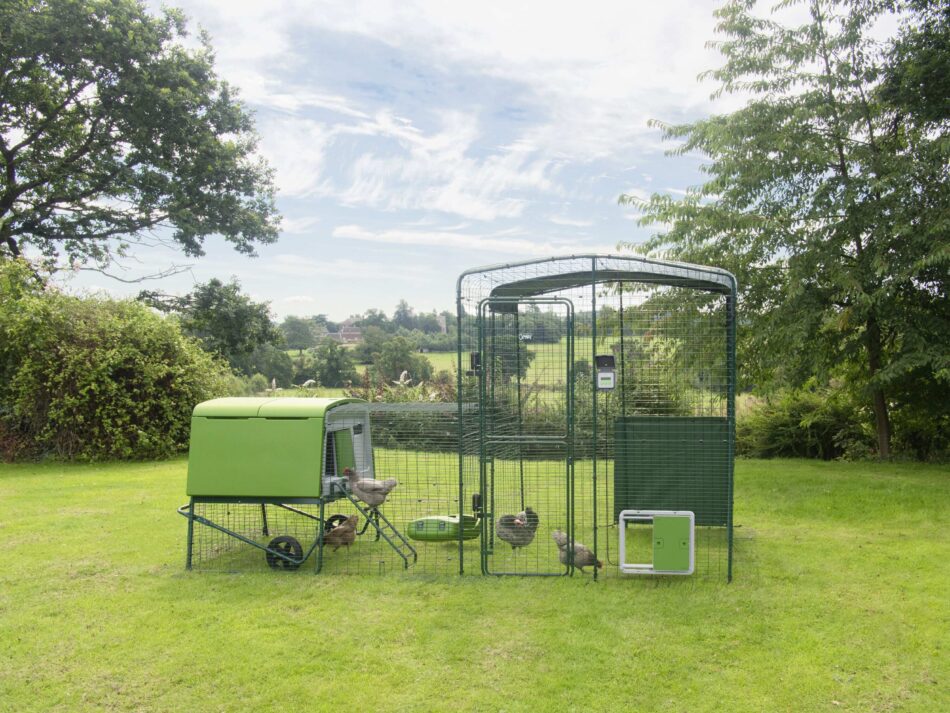
This entry was posted in Chickens
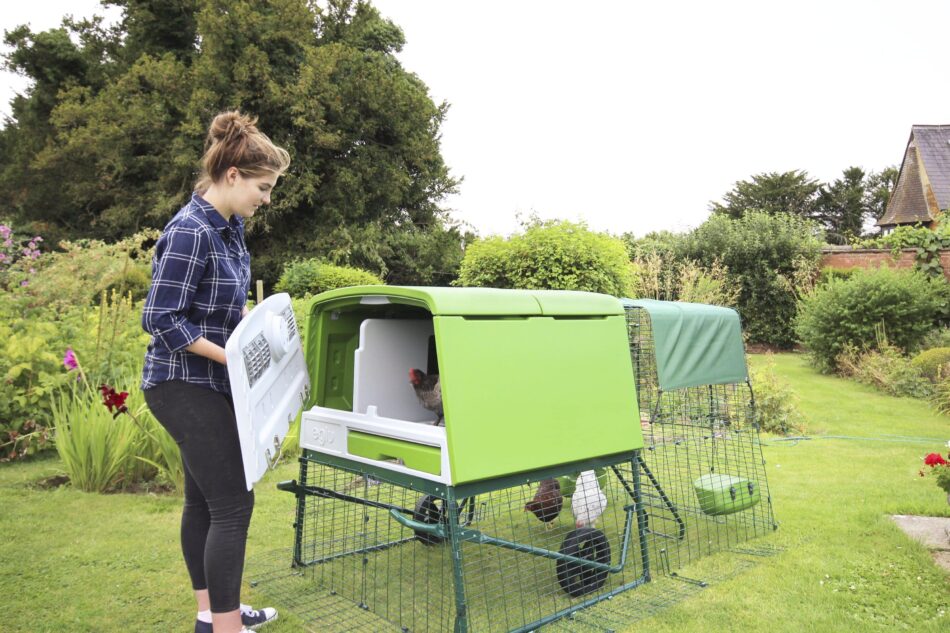
A quick search on the internet will provide a plethora of chicken coop options to purchase. But not all coops are created the same! At Omlet, our product designers know that keeping chickens is fun and simple, which is exactly why they created the easy to assemble and quick to clean Eglu Cube Chicken Coop.
Why you need an Eglu Cube
While wooden chicken coops have traditionally been used to house hens, there are better options available! Before you go buying a mini-house lookalike, take a read over all the reasons the plastic Eglu Cube is the best option:
- The material your coop is made of matters! The Omlet Eglu Cube is made of hard, durable plastic making it resistant to termites and parasites. Unlike a traditional wooden coop that needs to be treated, painted, and reroofed regularly, the Eglu Cube doesn’t require any of that maintenance – think of all the time and money you will save!
- The easiest to clean coop on the market! The product designers made this coop with clean-up in mind so all of the surfaces are easy to wipe down in minutes. No more need to worry about smelly chicken coops! In fact, all of the Eglu parts are easy to remove and even pressure wash clean if needed. Your hens will thank you for a sparkly clean and hygienically healthy home!
- It’s a weatherproof wonder! Chicken keepers from Florida to Fargo can attest to the outstanding weather performance of the Eglu Cube! Carefully designed with a unique double-wall insulation system, the Eglu allows your chickens to stay warm in the winter and cool in the summer. When tested against a traditional wooden coop in the cold winter of Germany, we concluded that a winter ready chicken coop like the Cube can make all the difference between a cosy night’s sleep and one spent shivering to keep warm!
Hassle-free Cube = hassle-free chicken keeping
Some people may object to keeping chickens for reasons that include smell, time commitment, and space. But the reality is that these are all just chicken myths, and with the right products and preparations, chickens are low-maintenance pets. The Eglu Cube from Omlet helps to make that job easier!
SMELL
So you think chickens in your backyard might create a bad smell? Well, the truth is, chickens are actually clean animals. The smell that many are afraid of isn’t from the chickens themselves, but rather from the chicken droppings. But, with the easy to clean Eglu Cube, you can spray down your coop in minutes and avoid any unpleasant odours.
TIME
Like any animal, owning chickens requires a time commitment! Just like cats and dogs, they need daily food and water and physical and mental stimulation. Other than that, they are self-sufficient animals! Investing in the Eglu Cube allows you to save even more on time with its easy assembly! We had the novice chicken-keeper in mind when designing this coop, so we created a product that is super easy to put together. In fact, you just need one tool to get started!
SPACE
Probably one of the biggest myths in owning chickens is that you need to have a huge backyard to house your hens! For the average chicken-keeper, a regular sized backyard will do just fine! The great thing about the Eglu Cube is that you can opt to add wheels to the coop allowing for it to be movable by one person to another location. What chicken wouldn’t like a house on wheels?
Step-by-step guide
Choosing the right chicken coop can be the hardest part of chicken keeping. So now that you have decided on the Omlet Eglu Cube, let’s take a look at the 7 simple steps to assemble your hen’s new house!
- STEP 1: Grab a screwdriver and a friend. Yes, that’s all you need to put together this super easy to assemble coop! All of the materials are included in the boxes upon arrival, so you simply need to lay everything out to get started. If you want, you can even watch this tutorial video to follow along each step!
- STEP 2: Now it’s time to construct the frame! With the help of a friend, follow the detailed step-by-step instruction manual to build your coop base. Made from heavy duty steel, this frame is not only strong but will keep your chickens safe and secure.
- STEP 3: Now it’s time to get rolling! If you opted for the wheel accessories, this step includes their installation. The moving mechanism of the Eglu Cube wheels was created to allow for one person to move the coop with ease!
- STEP 4: Time to install the run – a chicken’s favourite part! The size of the run you buy depends on how many chickens you plan on keeping. The goal should always be to give your chickens the most space you can – either free range in the backyard or with a bigger walk-in chicken run. And if you find it hard to decide which is best for you, just contact our customer service and we will be happy to help!
- STEP 5: You’re almost there! Now it’s time to assemble the cube house and attach it to the frame! Made from 100% recyclable and UV stabilized polyethylene (super strong plastic!), you will have peace of mind knowing your chickens are in the best built hen house on the market.
- STEP 6: It’s accessory time! One of the greatest benefits of the Omlet Eglu Cube is all the optional accessories you can add to your hen house! The essential feeder and waterer bins are constructed from the same strong material as the house and designed to be just as easy to clean! You can also add the automatic chicken coop door which allows your chickens (and you!) to sleep soundly at night knowing that predators cannot get in!
- STEP 7: All that’s left to do now is add your flock! You have just built an efficient and practical home for your chickens that can stay with them for years to come.
Maintenance of your coop
While Omlet products are known for their durability, we always recommend regular maintenance on all products to ensure you will get the most out of them! The Eglu Cube is practically maintenance-free with its super easy to clean design, but there are few things you can keep your eye on when out and about with your chickens to make sure stability and security are 100%.
- If you notice any run clips not as tightly secured, it may be time to replace them.
- If you are a seasoned chicken-keeper and purchased an Eglu Cube before summer 2019, you may start to notice some wear on the previously provided friction stair strips. Consider upgrading your coop with the Eglu Cube ladder grips that not only make it easier for your chickens to walk in and out of the house, but are more durable as well!
- While the cube house is completely covered and protects your chickens from the elements, many chicken-keepers add run covers for added protection when the chickens are roaming the run.
One of the greatest gifts of chicken keeping is, of course, the benefit of wholesome, fresh eggs! But chickens can also be very henertaining! After long, you will notice you are loving your chickens just as much as your four-legged pets. So when it comes to making sure they have the best life possible, be sure you get them the best house!
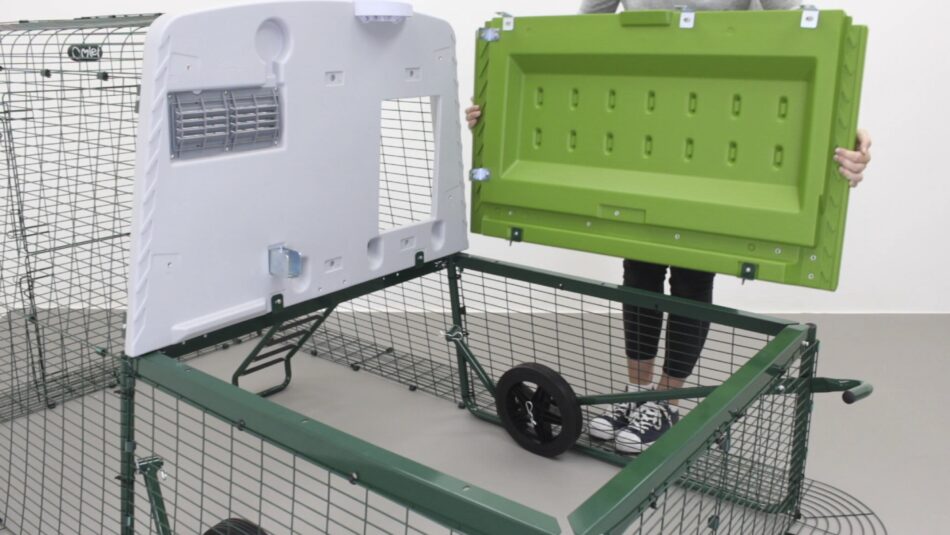
This entry was posted in Chickens
The Eglu Cube chicken coop is built to last – whatever gets thrown at it. The durable, twin-wall chicken house and heavy duty, steel weld mesh is strong enough to protect your chickens from hurricanes, tornadoes, bears, bobcats and more. These case studies are just some of the many stories from happy chicken keepers around the world.
This Eglu Cube survived a hurricane!

All parts for the Eglu Cubes are available as spares so if anything gets damaged you can easily repair it. Contact our friendly customer service team by
email or phone, and they’ll be happy to help.
The Eglu Cube chicken coop holds firm against strong winds and hurricanes, and is easy to tie down or move into a sheltered area. After Hurricane Ian hit Florida at 150 miles per hour, Jeremy was astonished to see his Eglu Cube still standing, unmarked in the thick of the aftermath.
“Our Eglu (unbelievably) survived Hurricane Ian. We are 3/4 of a mile from the Gulf of Mexico near where the hurricane made landfall. Venice is badly damaged. Our neighbourhood, in particular, took a very big hit.
Our entire back yard was destroyed. The fence is a complete loss. Several large (30+ foot) pine trees fell down, including one into the neighbour’s roof and one that snapped the power pole in half. But the Eglu did not have a single scratch. We moved the chickens back in right away.”
Jeremy – Florida, USA.
This Eglu Cube survived a bear attack!
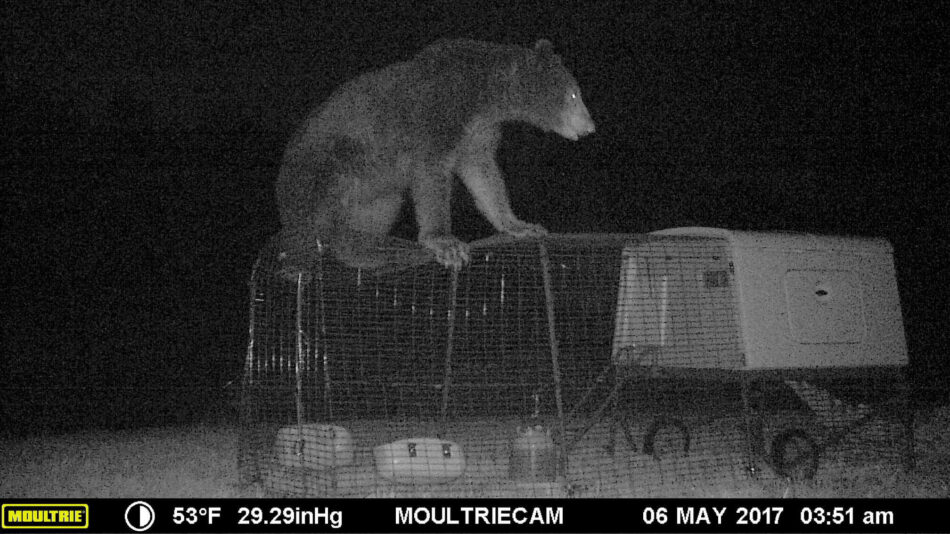
When you live in a rural area, with black bears for neighbours, it’s understandable to be worried about your chickens. But Tom’s Eglu Cube quite-rightly earned his trust when a 300 pound bear was unsuccessful in its attempt to break and enter his chicken coop in Virginia.
“We live in an area with black bears, coyotes, foxes, and other predators. Over the weekend our Eglu was attacked by a 300 pound black bear and despite the wire roof being smushed with its weight, the Eglu remained intact and no chickens were harmed. We most likely will need an electric fence but we were impressed with the coop being able to withstand the assault. Very impressed! Also, with 2 young children the Eglu is easy to clean and maintain – minimal maintenance required and our boys able to open and close the doors. Outstanding! The best coop we could have with our rural area and lifestyle”
Tom – Virginia, USA.
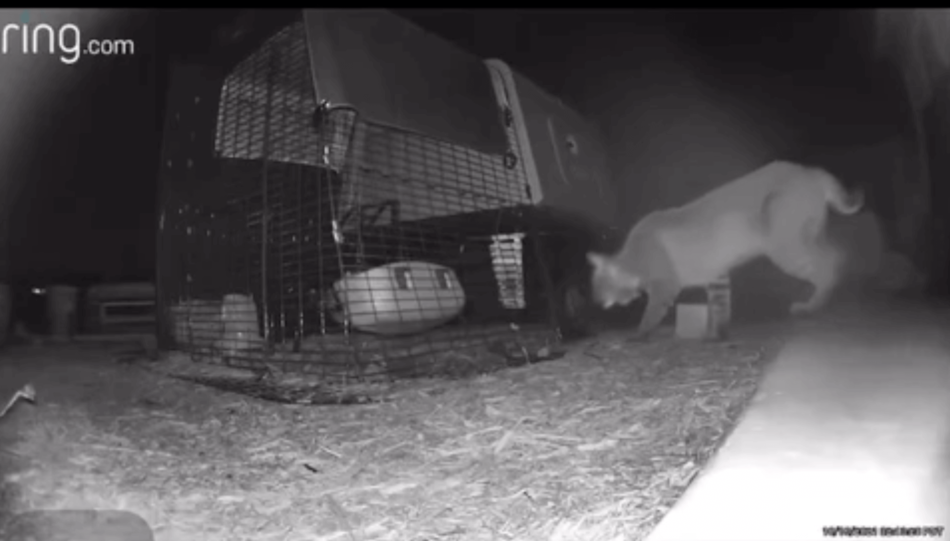
Over in California, Tracy and her sweet silkies also had an unwelcome visitor in the form of a large bobcat. But thanks to the Eglu Cube, Tracy enjoys peace of mind knowing her girls are safe and sound.
“We are the Lloyds, and we live in San Diego, CA. We have four silkies – Elsa, Nugget, Ickey, and Shuffle. They are the cutest and sweetest, little bunch. They like to stick together, and scratch for bugs, worms, and other treats.
The predator in the video is a bobcat, but we also have coyotes, owls, hawks, and more. Our house backs to a canyon, and we have frequent visits from various predators. We have so many visits, that I do not allow my poodles to go outside in the backyard unless they are next to us, and we are actively watching them, but I’m confident the hens are safe in their coop.
We purchased an Eglu Cube because we love our silkies, and we wanted to keep them safe. Although we still have a motion-sensor camera to monitor, the silkies have been happy and safe!”
Tracy – California, USA.
This Eglu Cube survived a fallen tree!
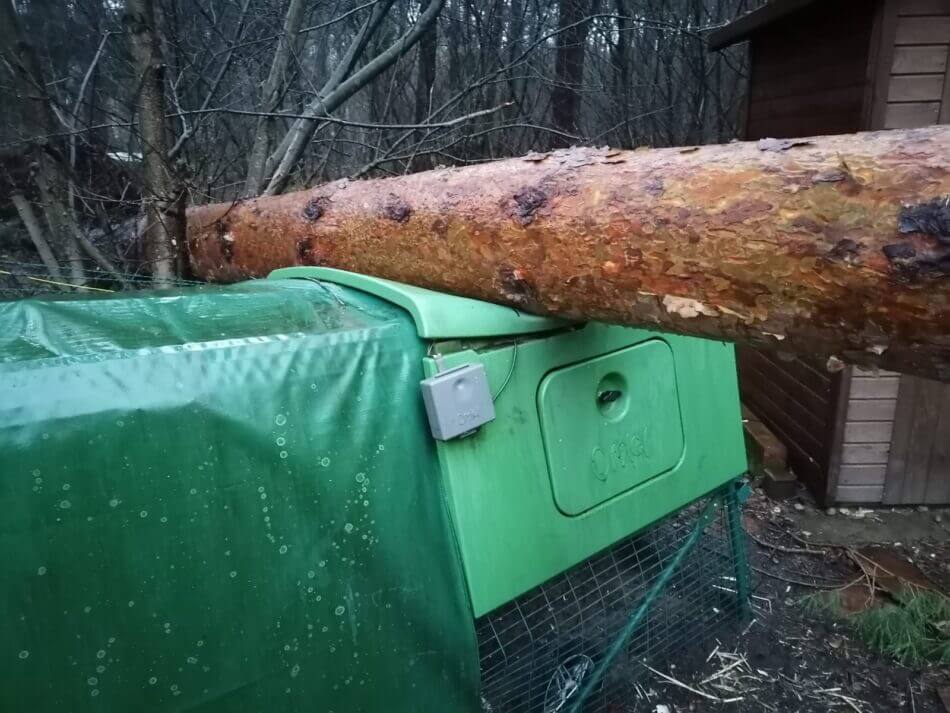
Thanks to the thick, twin wall house and steel frame, the Eglu Cube chicken coop is unaffected by the roughest of storms and its path of destruction. Anna from Germany saw for herself when a fallen pine tree squared up to the Eglu Cube.
Man, did we have a few stormy days! Everywhere in the neighbourhood, trees were falling left, right and centre, and one of them on the edge of our premises, exactly where our Eglu Cube chicken coop is!
The giant pine tree fell across our Cube, but when we came out to check on the hens we couldn’t believe our eyes. The tree was resting right on top of the Eglu, but it hadn’t been damaged at all. As soon as the Autodoor opened, the chickens walked out and started to scratch around as if nothing had happened, and we could collect fresh eggs that same afternoon.
After some serious chainsaw work we were able to investigate the Cube, finding that only one roof panel was damaged, but we could even bend that back a bit. Unbelievable!”
Anna – Germany
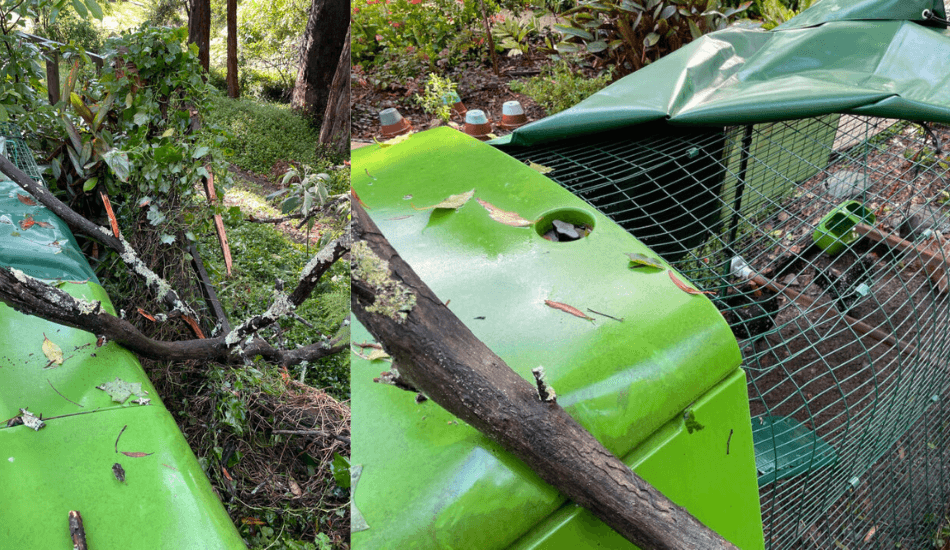
Months after replacing her rotten wooden coop, Ashleigh was relieved to find her hens unharmed after severe storms had blown down a large tree, crushing her fence, but stopped in its tracks by the reliable Eglu Cube chicken coop.
“We’ve had storms overnight and went to let the chickens out this morning to find a large tree had come down from the bush behind the house and had landed on our fence and chicken coop. The fence couldn’t withstand the impact, but the Eglu Cube did. We replaced our old wooden coop with the Omlet one a few months ago as the wooden coop was rotting in our humid mountain air, and we’re so glad we did. Not only is it so easy to clean, I don’t think our chickens would have survived the tree falling on the coop. The coop does need some repairs as the run and coop itself have buckled, but I still can’t believe how strong it is.”
Ashleigh – New South Wales, Australia.
Tornado – yep, this Eglu Cube survived one!
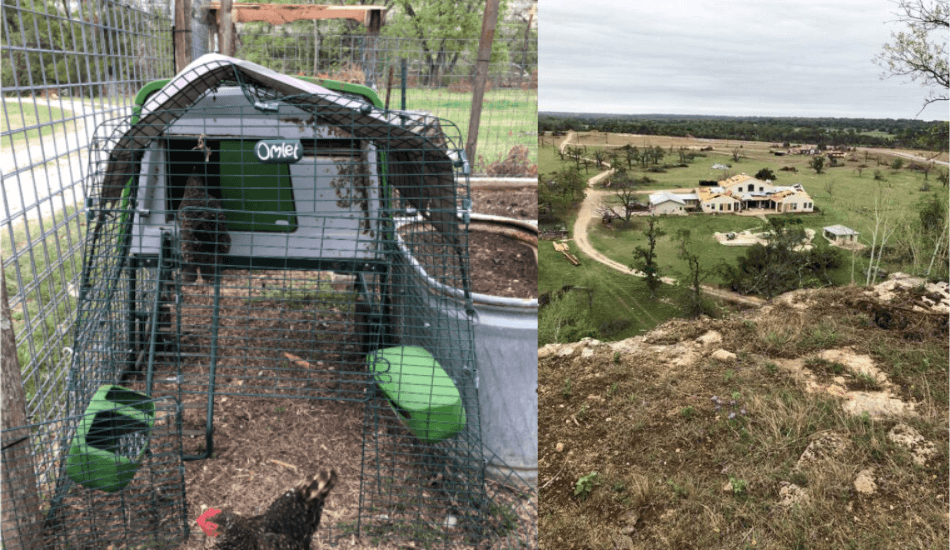
Despite needing a good clean and a reshape, Lori’s Eglu Cubes survived a direct hit from a severe tornado in Texas, and her hens were unharmed – though a little shaken by the whole thing.
“We sustained a direct hit from a F3 (almost F4) tornado in April. Much of our ranch was destroyed (hay barn completely gone, barndominium, horse stalls and woodshop required demo to slab, house currently unliveable). We lost two cows and many trees. But, we survived in our tornado room with our dogs and our 2 Omlet Cubes and all of our chickens survived. One Cube was completely upside down and the other was trapped by fallen tree limbs and debris. The chickens were trapped by our hawk netting that collapsed with the tree limbs; actually fortutios and I think they would have been blown away – ah, the story they could tell! We were able to turn the one coop upright and get them all in one for that first night. Yes, 12 wet hens can fit in an Eglu Cube!
While the run and skirting are bent up, and I had to remove a few pieces of skirting, they are still functional. The back door on one sustained a hit that broke a small piece of plastic that makes the handle a little loose, but still functional. The Autodoors still work, one of the shade covers survived, as did the food and water bowls! Other than being scratched up, very dirty and with misshapen runs, they are fine! They have since had a thorough washing and if you didn’t look at the bent run, you’d never know anything happened! Thanks for making such a great product!”
Lori – Texas, USA.
Eglu Cube – 1, Mountain lion – 0
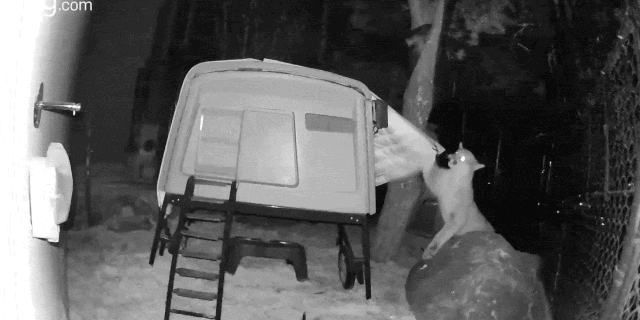
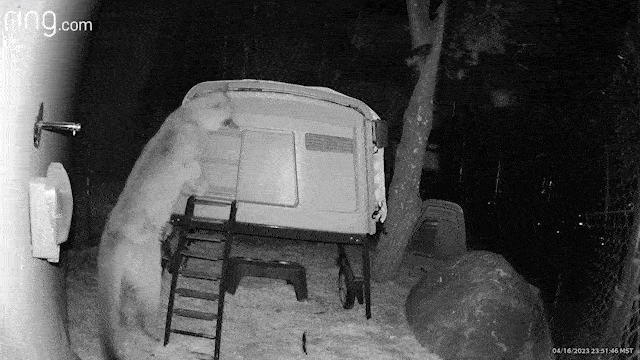
Pesky predators are no match for the Eglu Cube. Watch how this crafty mountain lion in Arizona made several attempts of sneaking their way into the Eglu Cube. But with its unique indestructible and anti-predator design, even the biggest of cats are left baffled by this coop.
Dug Rothrock – Arizona, USA.
This Eglu Cube saved hens from the flames
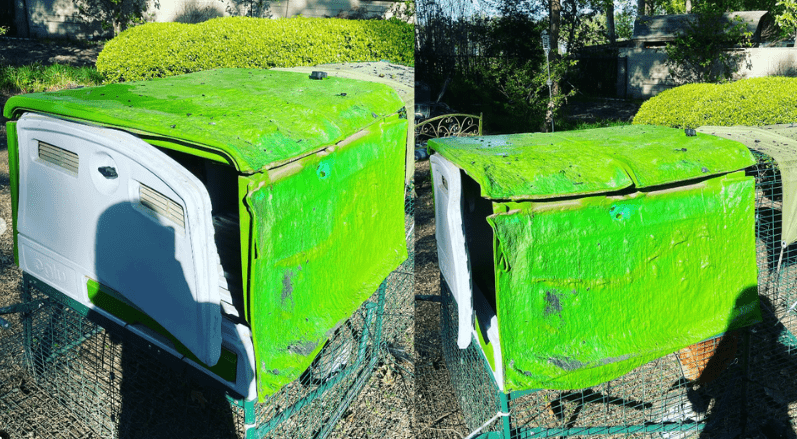
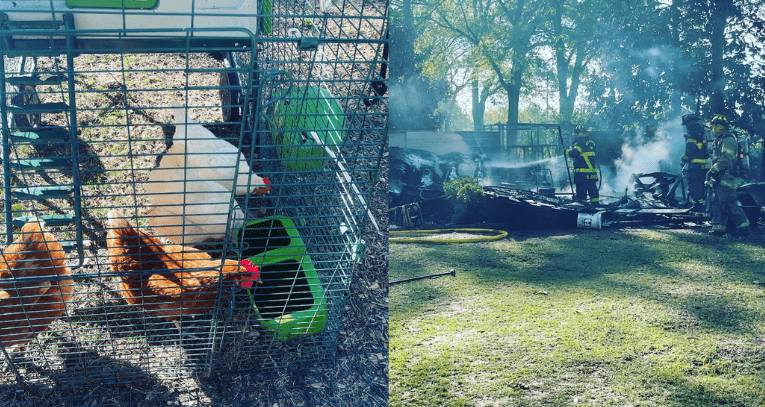
Disaster struck Erin from Arkansas when their backyard went up in flames. Fortunately, their hens were tucked safely away from the fire in their Eglu Cube chicken coop, which was able to withstand the terrifying event. Whilst the coop has been left with visual reminders of the blaze, Erins’s chickens survived thanks to the hard-wearing materials of the Eglu Cube.
Erin – Arkansas, USA.
So, how strong is the Eglu Cube chicken coop? From wild weather to wild predators, you and your chickens can rest easy with the Eglu Cube chicken coop, designed by Omlet and trusted by thousands of chicken keepers.
Got an amazing story to tell? If your Eglu has saved your hens from stormy weather or unwelcome visitors, please email us at blog@omlet.com.au.
This entry was posted in Chickens
It’s often hard to tell if a hen is laying. Hens do not produce the same number of eggs each week throughout the year, and there may be health- and environment-related changes to egg production, too.
It’s useful to know when a hen stops laying, as you can then give her a quick health check to identify the cause of the interruption. But how do you tell which chicken is not laying eggs? In a coup of six hens, in which the daily average number of eggs is five, it’s not immediately obvious which hens are laying.
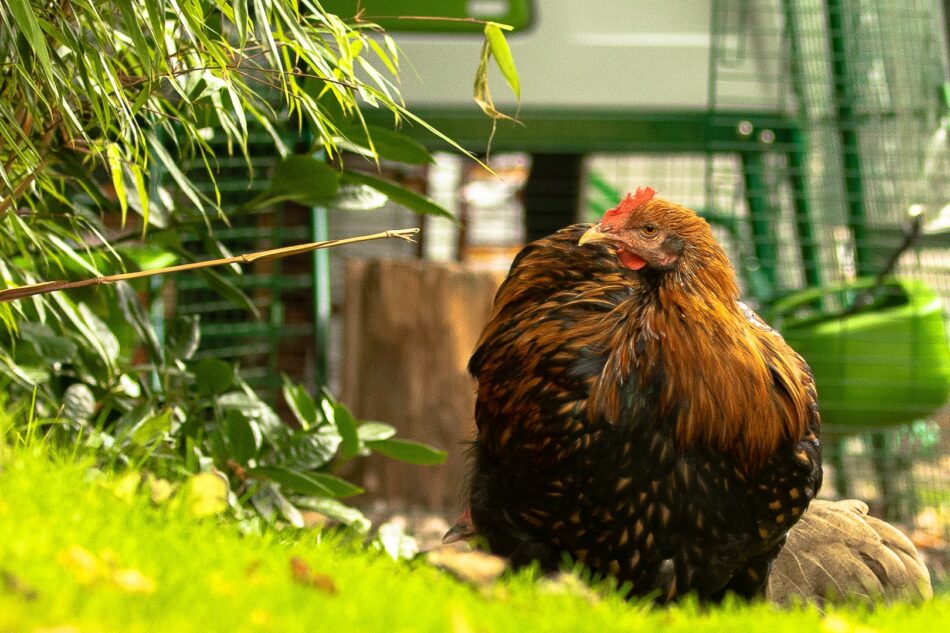
Seven signs that a hen has stopped laying
1. Age. This is the most obvious cause of a drop in egg production. Over her egg-laying years, a hen’s production will tail off. This is natural, and it does not mean the chicken has reached the end of its usefulness. All hens play a part in the social order of a coup, and a bird reaching the end of its egg-laying life will still be as feisty, active and lovable as the younger birds – and she’ll still lay the occasional egg.
2. Moulting. This occurs every year once a hen is 18 months old (although younger birds may shed feathers, too). The signs are very clear – lots of feathers lying in the coop, and bare patches appearing on the hen. During this time, chickens need to produce lots of new feathers, which is a physically demanding process. Consequently, egg-laying is reduced, and sometimes there will be several days without an egg. The moult tends to occur in the autumn, but it depends on when the hen first started laying. Moulting takes 8 to 12 weeks, occasionally longer.
3. Vent. A dry vent – the hole through which the hen lays her eggs – is a sign of no production. In a hen that is still laying, the vent will be moist.
4. Abdomen. Your chicken’s abdomen area should feel soft and rounded. If the area below the breast bone is hard and swollen, this can be a sign of egg peritonitis, a bacterial infection in the chest cavity. Your chicken will still produce a yolk but is free-floating in the abdominal cavity. Affected hens will stop therefore either completely stop laying eggs or only lay soft-shelled, thin, or misshapen eggs.
5. Comb and wattles. A healthy laying hen tends to have bright red comb and wattles. These become duller when she is about to lay, but turn bright red again once she has laid the egg. If the comb and wattles are pale or dull looking all the time, it could be a sign of illness.
6. The food dye test. If you put a small dab of food colouring on a hen’s vent, the colour will be transferred to the egg. The colour that fails to appear tells you who the non-layer is. This is only practical in smaller flocks, though, given the limited palette of food colourings…
7. No eggs. This isn’t as silly as it sounds! If you only have a few hens, and they are different breeds, you will often come to recognise which eggs are produced by which hen. In this case, the sudden disappearance of one particular egg-type will tell you who’s not laying.
Five reasons why hens stop laying eggs
1. Temperature and sunlight. Seasonal factors play a part in egg production. As the daylight hours lessen in autumn and winter, hens tend to lay fewer eggs. In the depths of winter, the low temperature becomes the cause, as a hen needs all her energy to produce body heat. With her resources diverted to this essential function, egg-laying is put on hold.
2. Stress. Any form of stress will tend to interrupt or stop egg production. Stress can be brought on by several things, including parasites, bullying, injuries and fear (of noisy dogs, for example).
3. Diet. Poor diet can impact egg production, too. If a hen is laying, she needs all the essential nutrients – not just calcium – to produce eggs. Top-quality layer’s pellets will contain everything the hen needs. A hen that fills up on treats before filling up on pellets may become malnourished and stop laying. It’s a good idea to let the chickens feed on their pellets first thing in the morning and last thing at night, and only offer corn and treats in the middle of the day.
4. Broodiness. A broody hen – that is, a hen who has decided to sit on her eggs in an attempt to hatch them – will stop laying. There are several ways of discouraging broodiness, but some hen breeds are more prone to it than others. If all attempts to dissuade her from leaving the nesting box, you have the consolation that after 21 days – the time it would take for a fertilised chicken egg to hatch – the hen’s self-inflicted ordeal will be over and she will resume normal life – including egg-laying.
5. Change of routine. If you move the hen house or introduce new birds to the flock, or if one of the hens dies, the birds’ routine and pecking order will be interrupted. This often causes them to stop laying for a short time, until their social lives settle down again.
Four ways to encouraging laying
1. Comfy coop. The first thing to do is to make sure the hens’ environment is adequately equipped and comfortable. Check for red mites, as an infestation of these nocturnal parasites can stop egg production. Reduce drafts and make sure there is no bullying going on – often a sign of an overcrowded hen house.
2. Light. Some chicken keepers install lights in the coop to encourage laying in the colder months of the year. However, bear in mind that a chicken can only lay a finite number of eggs in its lifetime. If she’s naturally programmed to lay 1,000 eggs, encouraging her to lay regularly throughout the winter will simply reduce her laying life.
3. Eggs. If an apparently healthy hen isn’t laying, she can be encouraged by leaving eggs in the nesting box, or placing rubber ones, or even golf balls, in the spot where she is supposed to lay. The sight and feel of these will encourage her laying instincts.
4. Reduce stress. Discourage dogs from disturbing the hens, and make your run and coop are as predator-proof as possible. Equally important, make sure the run isn’t overcrowded, and provide enough roosting space in the coop for all the hens to rest comfortably.
Disappearing eggs
If your hens are free-ranging, they will sometimes lay an egg in a quiet corner of the backyard. This can become habit-forming, and if she’s doing it in secret, you may reach the incorrect conclusion that the hen isn’t laying.
A healthy hen who does not appear to be laying may be the victim of egg sabotage. A predator, a human thief or an egg-eating chicken might be removing the evidence of her labors. The best way of preventing this is to encourage your hen back to the nest box for laying. In crowded coops, a hen will sometimes seek an alternative laying place if the boxes are all full when she feels the urge to lay.
As a hen ages, she will produce fewer eggs. If you are uncertain of the age of your chickens, there is a simple test you can conduct that might sometimes give you a clue. Place your hand gently on a hen’s back. If she immediately squats down, it means she is still fertile and therefore producing eggs. Hens squat when they are mating, and it is an automatic response.
Although egg production drops as a hen ages, it will often continue throughout her life. The occasional egg from an old hen always reminds you what a wonderful friend she’s been throughout your long time together!
This entry was posted in Chickens
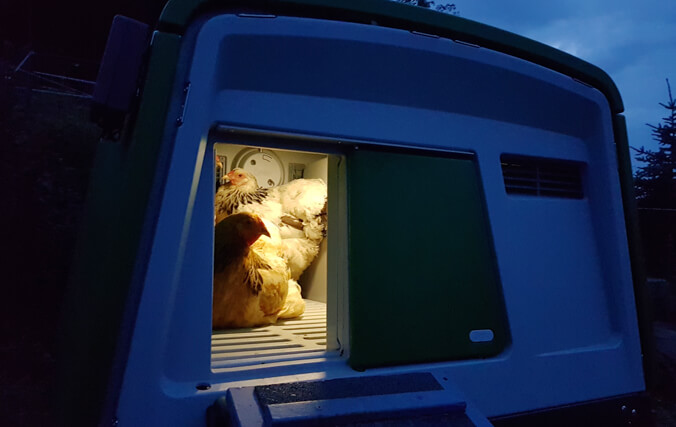
Your chickens’ coop should be a space for your flock to eat, drink, lay eggs, and sleep. It should also be a place for your chickens to feel safe and be protected from the outside elements or any danger. However, sometimes chickens may suddenly decide that they do not want to go into their coop at night, which can be for a number of reasons. Here are some explanations as to why this could be happening.
A Broody Hen
Hens can get broody, regardless of if you have a rooster. Although many hens will decide to stay in the nest of their coop so that they can sit on their eggs, others like to search for a quiet space away from the coop, which can mean remaining outside the coop all night.
Moving a broody hen can be highly stressful for them, so should you decide that it’s best to move your hen inside the coop, due to safety concerns, you need to take great care when doing so. One way to start is by collecting your hen’s eggs regularly (twice a day). Be sure to wear leather gloves when doing so, as a broody hen is likely to be aggressive around you as they are very protective of their eggs. You’ll also want to reduce the light supply when you move her, as the moving process situation will be less traumatic in the dark.
Predators
Predators such as foxes, cats, rats, and badgers could be one reason as to why your chickens have stopped going inside the coop at night. These animals will spook your flock, with smaller predators such as badgers having the potential to gain access inside the coop by climbing over the fencing, or squeezing through small openings in the coop’s wiring.
Luckily, there are a few steps you can take to deter these animals and have your chickens back in their coop every night. One option is to get a motion sensitive light installed, which will scare off any unwanted guests. Alternatively, take a look at the Omlet chicken coop range. All of the Omlet coops are predator resistant, which will reassure you that your chickens will be safe from any night time visitors. With anti-tunnel skirts that lie flat on the ground, and heavy duty steel weld mesh, these features will help to prevent animals from digging in. You can also purchase the Omlet automatic coop door which shuts your chickens away in their coop at night to keep your flock secure, enclosing them until the time you set for the door to open in the morning.
An Overcrowded Coop
Chickens need their own personal space, hence why many chickens are also kept free range. Not only is overcrowding an unpleasant experience for chickens, causing them to avoid the coop at night, it can also lead to further complications such as the build up of ammonia and an increase in disease. The solution? The more space the better! For size reference, the Omlet Large Eglu Cube chicken coop can comfortably accommodate six large hens or up to ten bantams.
Tensions Amongst Your Chickens
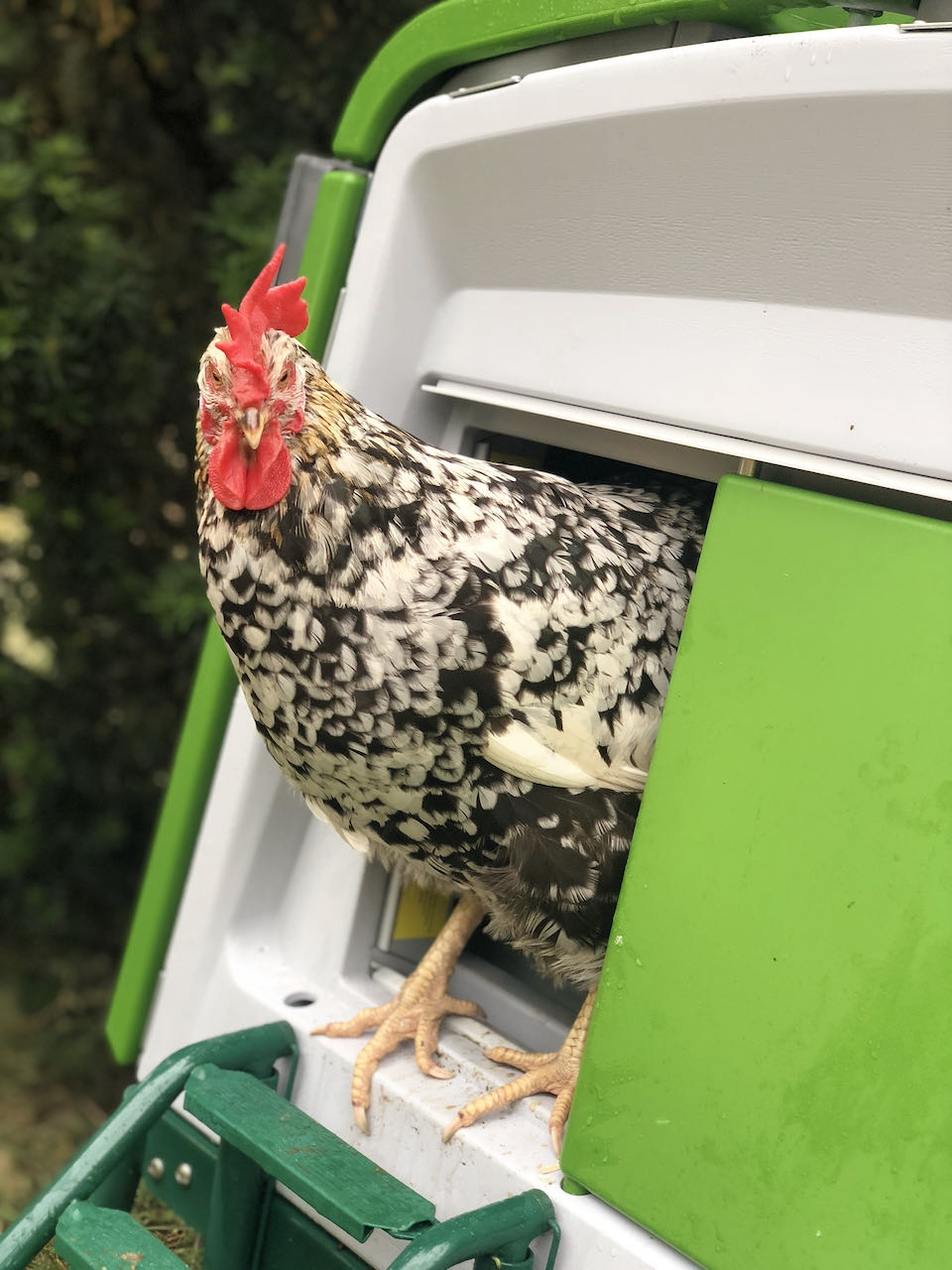 Unfortunately, bullying amongst chickens happens, and isn’t actually too uncommon of a problem. Chickens naturally create a pecking order, whereby the flock will establish themselves in a social hierarchy of strongest to weakest chicken. However, if aggressive behaviour continues after the head rooster, or the dominant hen in their absence, has found their way to the top of the ladder, you may be dealing with a bully. Common signs are missing feathers from a chicken’s back, unusual weight loss, reduced egg production, or blood from where the victim has been pecked, all of which could lead to a chicken/s refusing to go into their coop at night.
Unfortunately, bullying amongst chickens happens, and isn’t actually too uncommon of a problem. Chickens naturally create a pecking order, whereby the flock will establish themselves in a social hierarchy of strongest to weakest chicken. However, if aggressive behaviour continues after the head rooster, or the dominant hen in their absence, has found their way to the top of the ladder, you may be dealing with a bully. Common signs are missing feathers from a chicken’s back, unusual weight loss, reduced egg production, or blood from where the victim has been pecked, all of which could lead to a chicken/s refusing to go into their coop at night.
To stop the bullying, and therefore get your chickens back in their coop at night, first try to establish the cause. Common reasons for bullying can be an injured or ill bird, having a large flock, or your chickens being bored. However, should the bullying continue after attempting to resolve what you believe to be the cause of conflict, you can purchase anti-pecking spray, which will discourage feather pecking. Alternatively, separate the bully from the flock. Isolating the bully for a week may mean that they lose their dominant position in the hierarchy once they are reintroduced.
Mites and Parasites in the Coop
Pests are a very common cause for chickens to have stopped going to their coop at night. Red mite in particular is a likely culprit, a parasitic mite that lives inside chicken housing and lays eggs in cracks near nests. They can make your chickens restless at night, as they live inside chicken coops and crawl onto the chickens to feed on their blood as they sleep. Only active during warmer weather, red mites are also more likely to strike wooden coops.
Red mites are not the easiest thing to get rid of, however, one solution is to purchase red mite treatment, which works by immobilising pests with its sticky consistency. Rest assured, it’s also completely safe to use in the chicken feeding area, so you do not have to have any concerns about your flock digesting the product.
Luckily, chickens are creatures of habit, so once you’ve identified the cause, you should be able to get your flock back into the coop at night in no time!
This entry was posted in Chickens
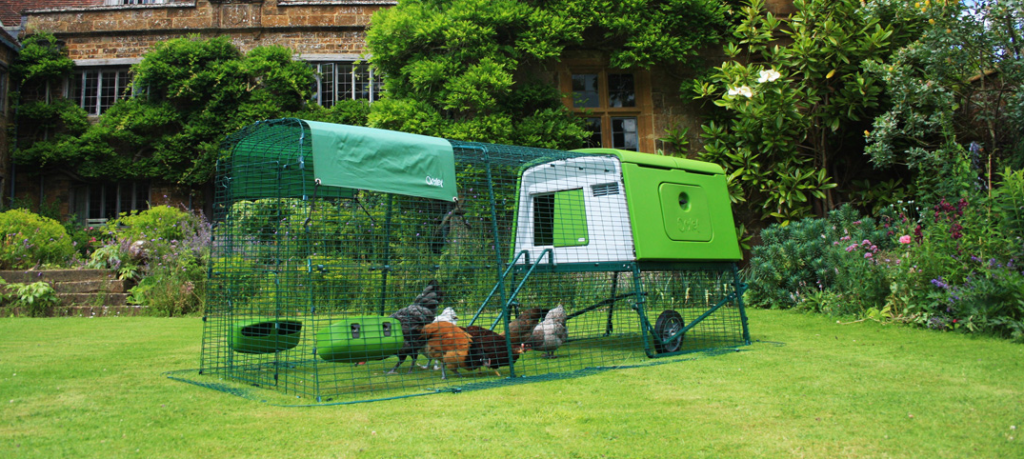 The metal chicken runs are designed to be used outdoors for years to come. However, we recommend that you check the run regularly for signs of corrosion, especially if you live somewhere with extreme weather conditions or close to the sea. Corrosion will occur if the coating has been scratched or scraped for example. If you do see some, remove any loose rust and touch up with a weather resistant paint.
The metal chicken runs are designed to be used outdoors for years to come. However, we recommend that you check the run regularly for signs of corrosion, especially if you live somewhere with extreme weather conditions or close to the sea. Corrosion will occur if the coating has been scratched or scraped for example. If you do see some, remove any loose rust and touch up with a weather resistant paint.
Are you a long term Eglu or Walk in Run owner? Omlet products are known to be extremely long lasting, but we do recommend checking over your coop and run every year for signs of wear and tear, and to remember the little maintenance needed to keep your coop in tip top condition and your pet happy and healthy. You may have also missed some of the new products we have developed over the years to make the coop and runs even better. Take a look at ways you can upgrade and improve your Eglu below!
Run Clips
When you carry out your regular deep clean, make sure you have a quick walk around the run and check the security and stability of the run panels. In time, the run clips can age and become weaker. If you notice that run clips are cracking when you open them or move the coop and run, or that there are some clips falling to the ground, you should consider refreshing all the run clips on your coop.
We have now made it super quick and easy for you to find the right pack of run clips for your Eglu or Walk in Run. Take a look here.
New Ladder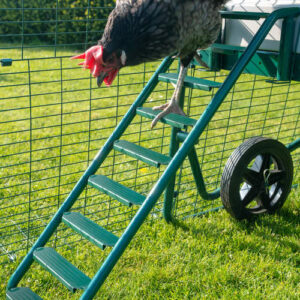
If you purchased your Eglu before summer 2019, you may not have benefited from the new Ladder Grips we have designed to resolve the problem of some chickens disliking the metal coop ladder, or being too small for the steps. The ladder grips replace the black friction strips, clipping on securely and easily to provide a wider platform for chicks to climb up on.
You can buy ladder grips for your Eglu Cube here or for your Eglu Go UP here, for £4.99.
Autodoor and Coop Light
We’re sure you haven’t missed the Automatic Chicken Coop door that can be attached straight onto your Eglu Cube or Walk In Run, but have you seen that you can also attach a coop light to guide your chickens in at night? The light is powered by the control panel of the Autodoor, and will automatically come on 5 minutes before the door closes. As soon as the door has closed for the night, the light turns off.
Run Covers
In high winds and torrential rain, old run covers can take a beating. If you have had your run covers for some time and they are looking a bit worse for wear, it might be a good idea to invest in a new set of covers to ensure your chickens continue to be fully protected from the elements.
Discover our wide range of run covers for all Eglus here.
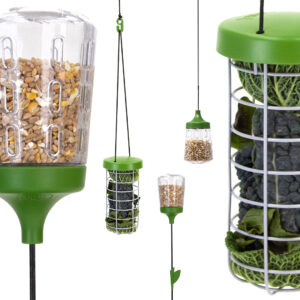 New hentertainment
New hentertainment
We have also introduced new feeders and treat dispensing toys in the last few years, which your chickens are sure to love.
The Caddi Treat Holder is ideal for larger treats, such as fat balls or vegetables from your garden, and hangs in your run to keep food off the ground and prevent mess on the run floor. The Peck Toys are a rewarding, slow release solution for treat-dispensing which your chickens will be entertained by all day. The Pendant hangs from the run, while the Poppy is put into the ground – perfect if your chickens are fully free ranging.
We’re here to help
If you are unsure about the condition of your Eglu or your run, please contact our friendly and knowledgeable Customer Service team. They can give you advice on how to maintain your product, making sure it’s in top condition for many years to come!
This entry was posted in Chickens
As we head into summer and the weather begins to warm up, you might be wondering how you can help your chickens keep cool in the hotter months. Get prepared now and catch up with our previous blog posts on keeping happy and healthy hens during summer below…
7 Ways to Help Your Chickens Stay Cool This Summer
Did you know, that chickens can’t sweat? Instead, chickens use their legs, combs and wattles to lead heat away from their bodies. They also pant and spread their wings in order to get some air through their feathers. But what can you do to help?
From water to dust baths, here’s 7 simple but effective tips to help your chickens stay cool in the hot weather…
10 Things Not to Do in Summer if You’re a Chicken Keeper
From 7 things you should do, to 10 things you shouldn’t do this summer if you’re a chicken keeper! This advice is just as important as the tips above for ensuring a comfortable environment in the warmer weather, and also preventing your chickens from overheating.
How to Protect Your Chickens from Red Mite
Red mites, or Dermanyssus gallinae, are without a doubt backyard chicken keepers’ worst enemies! They are nocturnal creatures living in cracks and crevices of the coop, and they only come out at night to feed on chicken blood. Most long term chicken keepers will have encountered these parasites, and can confirm that they are more destructive and difficult to get rid of than all other pests combined.
Learn how to treat and prevent red mite infestations in your coop to keep your chickens happy this summer.
How the Eglu Keeps Chickens Cool
Traditionally chicken coops and rabbit hutches have been made from wood. This has its advantages: it’s an easy material to work with, it’s customisable and it looks attractive. However, when it comes to coping with the weather, it can leave a lot to be desired. Wood is not a very good thermal insulator, meaning if it’s hot outside the temperature will transfer through to the inside quickly.
If you’re using a wooden coop, it might be a good time to consider upgrading to a better insulated and ventilated house before the worst of the hot weather hits. Learn how an Eglu keeps chickens cool in this blog post.
This entry was posted in Chickens
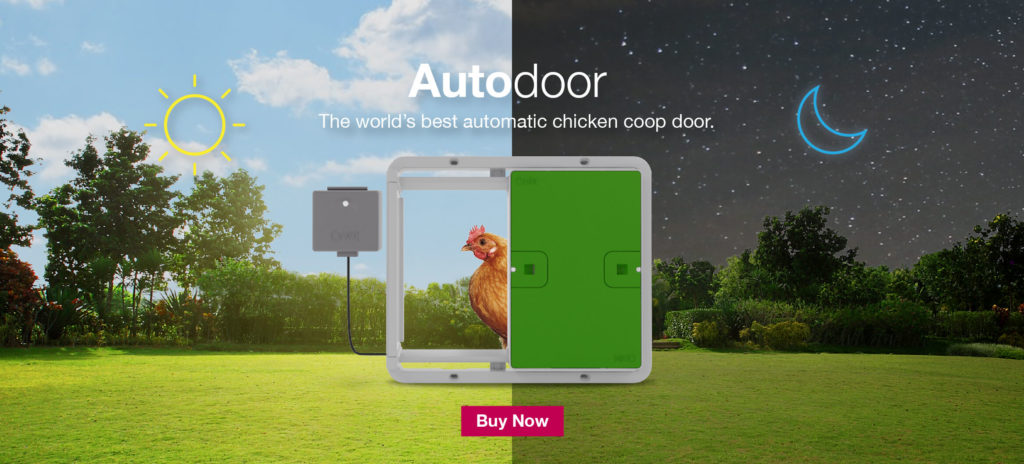
Did you know that over 60% of chicken keepers aren’t getting enough sleep?! Omlet has the solution as they launch the New Automatic Chicken Coop Door.
In the last decade chicken keeping has become a hit with families wanting a slice of the good life, propelling hens into the top ten list of pets. The reasons are clear: a supply of fresh eggs that’s the envy of your friends as well as teaching children important lessons of where their food comes from suggests that chickens really are the ultimate pet.
However, a recent survey found that over 60% of chicken keepers wish they could spend longer in bed in the mornings with many admitting they would be willing to pay up to $400 for a solution that could prolong their lazy mornings in bed! 1 in 6 couples even admitted to regularly arguing about who should let the chickens out. What will save the country’s chicken keepers from tiredness and possibly even divorce?
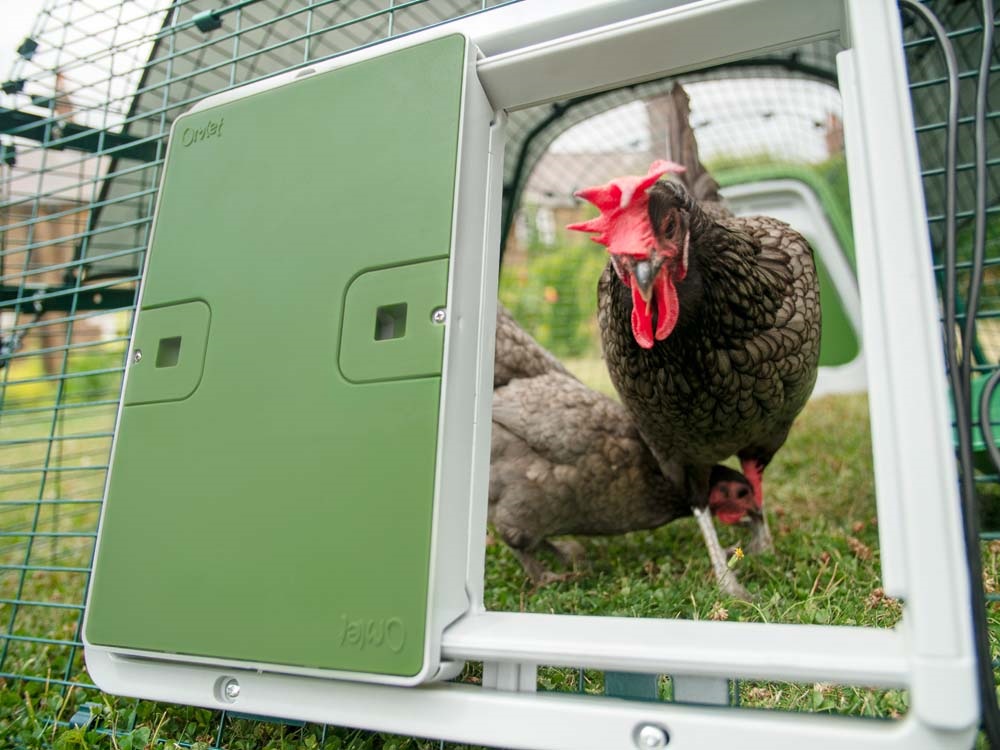
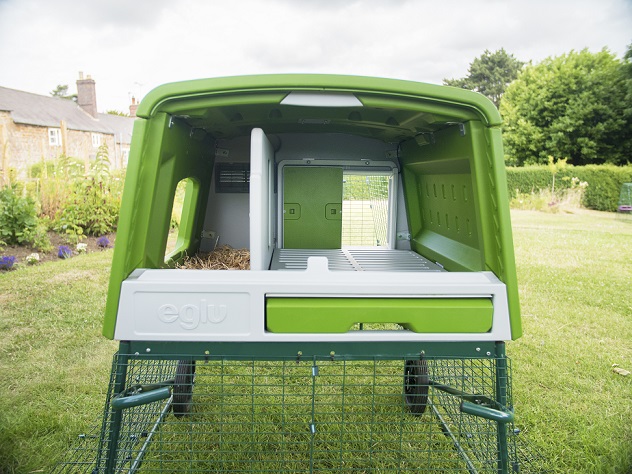
Introducing the brilliant new Automatic Chicken Coop door opener from Omlet. Designed to work with the best-selling Eglu Cube as well as any wooden chicken coop. Omlet’s Automatic Chicken Coop Door Opener is battery powered and combines both a timer and a light sensor, giving you the ultimate flexibility and control.
Omlet’s Head of Product Design, Simon Nicholls, said: “We know our customers love their chickens and always want the best for them, that’s why we designed the Autodoor so that the hens could get up when they want, which can be quite early in the summer. It was also important to ensure that it works as well at closing the coop at night and in all weather conditions too, so we carried out extensive testing in several different countries over 2 years to perfect the design.”
The unique integrated frame and door design comes with everything you need to attach it to your chicken house or run and has been tested to work down to -20 deg C. Like a personal chicken coop concierge, the Autodoor will always make sure your chicken’s coop is securely closed at night even when you’re running late.
Sharon Burton, who has kept hens for 4 years in Oxford, believes the Autodoor has even saved her marriage! “There’s nothing I wouldn’t do for my chickens. I buy them the best food, I sprinkle dried flowers in their nest box to keep it fresh, but I always felt guilty if I didn’t hop straight out of bed at the crack of dawn to let them out and whenever I asked my husband Paul to do it he would pretend to be asleep! When Omlet asked me to test the Autodoor I was delighted, it’s saved my marriage!”
Omlet’s new Automatic Chicken Coop door opener is available now to order! Prices starting from $269.99.
This entry was posted in Chickens
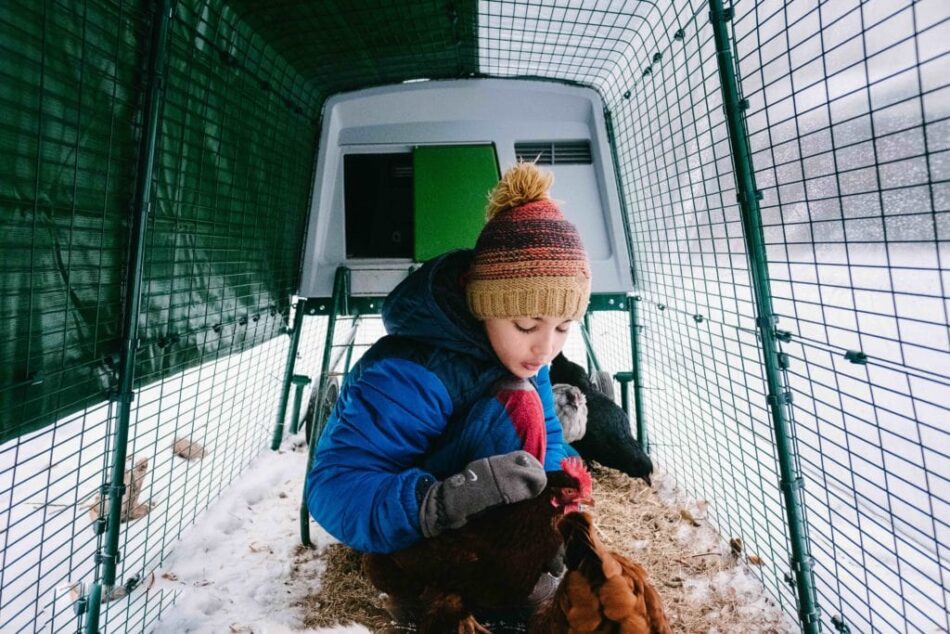
Insulating your chicken coop and getting your flock ready for winter is vital for their health and happiness. Most chicken breeds cope well in moderately cold temperatures as long as they have a well-insulated, dry coop. Chickens normally acclimatize to the cold weather, so if you have an insulated coop such as an Eglu Chicken Coop, you won’t need to fret during the cold months. In fact, chickens are able to adapt to the cold much better than hot weather! But with a little extra planning and preparation, you can ensure that your flock not only endures the winter, but thrives in it.
Why you should use an insulated chicken coop
Whilst chickens tolerate the cold well, ensuring your chicken coop is insulated during the cold months can promote their health. Whether you live in a state such as Alaska that is cold all year round, or experience warm summers followed by cold winters it’s vital you choose a coop suitable for the weather.
Our range of Eglus are designed with warmth as a core aspect. With a unique double-wall insulation system, you’ll find that our coops work in a similar way to double glazing. Your hens’ body heat is trapped inside whilst ensuring cold air cannot get into the sides of the coop. When comparing Eglus to a traditional wooden coop, you’ll discover that the Eglu provides far more insulation.
The insulation of our chicken coops is not the only benefit they provide. They are easy to assemble, easy to clean, portable and simple to attach to chicken runs. This will allow you to give your flock the space they need to roam during the day, as well as a cozy spot to sleep at night.
How to easily insulate your chicken coop
Whilst our chicken coops are naturally insulated, in really cold temperatures you may wish to insulate their home even more. Our Eglu Extreme Weather Protection are designed to perfectly fit your coop for added insulation. The temperature blankets are filled with a heat trapping recycled material that is breathable whilst keeping your pets warm. They are simple to fit to your Eglu and are easily secured with bunjees.
However, if you do not have an Eglu there are other ways to insulate your coop:
Weather protection & insulation for wooden coops
Your chickens’ coop must be waterproof! Most chicken breeds do well in the cold so long as they are dry. Chicken coops should also be insulated enough to remain warm inside even in the cold of winter. Here are our tips for insulating a chicken coop:
- Keep your coop and run dry – you can use coop covers and tarps to do this.
- Spray foam insulation – you can hire someone to insulate your chicken coop with spray foam to help trap heat inside your hens’ nest.
- Fiberglass insulation – using fiberglass insulation is an easy way to add DIY warmth.
- Wool blankets – adding wool blankets to the smalls can help to keep the coop insulated.
Ventilation whilst keeping cozy
A well-ventilated chicken coop will ensure that plenty of fresh air gets inside the coop. This will keep the odors down and avoid moisture build-up. Whilst you want to stop chilly drafts, a chicken coop without ventilation will retain moisture along with heat. And while some air circulation is good, make sure the coop is draft-free.
Elevation to reduce dampness
Height can also be an issue when making sure chicken coops are insulated. Coops should be raised off the ground to prevent the base becoming damp. For larger flocks, the Eglu Cube is an excellent choice for both insulation and elevation. If your coop doesn’t have legs, you can place bricks under the coop to allow air to circulate and reduce dampness. Always make sure you place or build your chicken coop and run-on high ground that won’t flood during heavy rainfall.
Size of the coop
It seems counterintuitive, but chicken coops can actually be too big. When the coop is too big for the size of the flock you have, your chickens won’t create enough body heat to warm up the space. This is why it’s so important to understand how much space your chickens need, when deciding which coop to buy. Chickens huddle together and keep each other warm, so they don’t need much space in their sleeping quarters. Try not to open the door of the coop at night when your chickens are roosting as it can compromise your insulation. Be mindful that this pent-up body heat is keeping them warm, so make coop and egg checks quick! If you have a large coop or barn and just a few chickens, you can place a large cardboard box on its side, half filled with chopped straw or wood shavings in a corner to help them conserve their body heat.
Keeping your chicken run insulated
It’s important that at least part of your chicken run is covered during winter months. Using weatherproof chicken run covers will help reduce how much snow can build up inside the run. You can also build a greenhouse-style addition to your coop, covering it with clear plastic, which will help convert sunlight into warmth. To prevent areas under the run from becoming too muddy, cover wet spots with pelleted pine bedding (usually used for horse stalls). Mud is a breeding ground for poultry parasites, so muddy areas should always be addressed.
Perches for cold chickens
Give your chickens plenty of places to roost. To prevent their feet from getting too cold on the frozen ground, you’ll need to give your chickens a place to perch in both their coop and run. The perches need to be wide enough so that the chickens can cover their toes with their feathers to thaw out chilled toes. By placing freestanding chicken perches or wire-mounted chicken perches, you’ll give multiple hens the opportunity to warm their feet while they’re out of the coop.
Cleaning your coop in winter
Keep your chicken coop clean and dry. Clean the droppings from inside the coop daily and replace bedding as necessary. By keeping the coop both dry and clean, you will help to prevent moisture buildup, which can lead to frostbite on your chickens combs and wattles.
Caring for your hens in cold weather
Keeping your chickens fit and healthy in winter goes beyond just insulating your coop. Here are our top tips for happy winter chickens:
Water in winter
It is important your flock always has a source of fresh, unfrozen water. Depending on where you live, this can pose a challenge. To prevent frequent defrosting, you can invest in a heated waterer or heated poultry drinking base. You can also insulate the water like you have your coop, by wrapping the chicken drinkers up in a layer of bubble wrap to keep the water thawed for longer. Don’t place the water inside the coop, as it will increase humidity levels.
Chicken feed in the cold
During winter your chickens feed consumption will be higher than in the spring/summer. Often chickens enjoy warm feed, like cooked lentils or warm oatmeal with some raisins or other small, dried fruits. Give your hens extra corn or scratch inside of a peck toy for both physical and mental stimulation in the afternoon, as this will heat them up internally as they digest it overnight. Offer hay or dried grasses for extra ruffage to fuel their metabolisms. Hens will decrease or even stop laying eggs in the winter to conserve energy. But you can help encourage hens to continue laying by providing adequate feed – both in quality and quantity. Supply layer pellets to give the right nutrients your egg-producers need throughout the winter.
Take care of their combs and wattles
If it gets extremely cold during the winter, your chickens’ combs and wattles can be in danger of getting frostbite. Most hardy breeds have small combs, but if you have chicken breeds with very large, floppy combs you will need to gently rub Vaseline on their combs and wattles. You will also need to keep an eye out for coughing, sneezing, and general symptoms of being unwell.
Vermin
Remember at this time of year, there are hungry rats and mice attracted to the chickens feed and water. Take extra care with the storage of your feeds. Store feed away from the coop and keep it in an airtight container. If you notice any signs of vermin, remove the feeders and drinkers at night, when they are most active. Offer kitchen scraps or fresh vegetables in a Caddi Treat Holder to keep the floor of your flock’s run free of tempting treats for unwanted visitors.
Fighting winter boredom
With less grass and weeds to munch and fewer bugs to feast on, your chickens will experience boredom in the winter. This can lead to behavioral issues, like feather pecking, egg-eating etc. Prevent boredom by giving your chickens toys like Chicken Swings, perches, piles of leaves, mirrors, or even a xylophone mounted to the run! Keeping your chickens hentertained will ensure they’re mentally stimulated and kept busy.
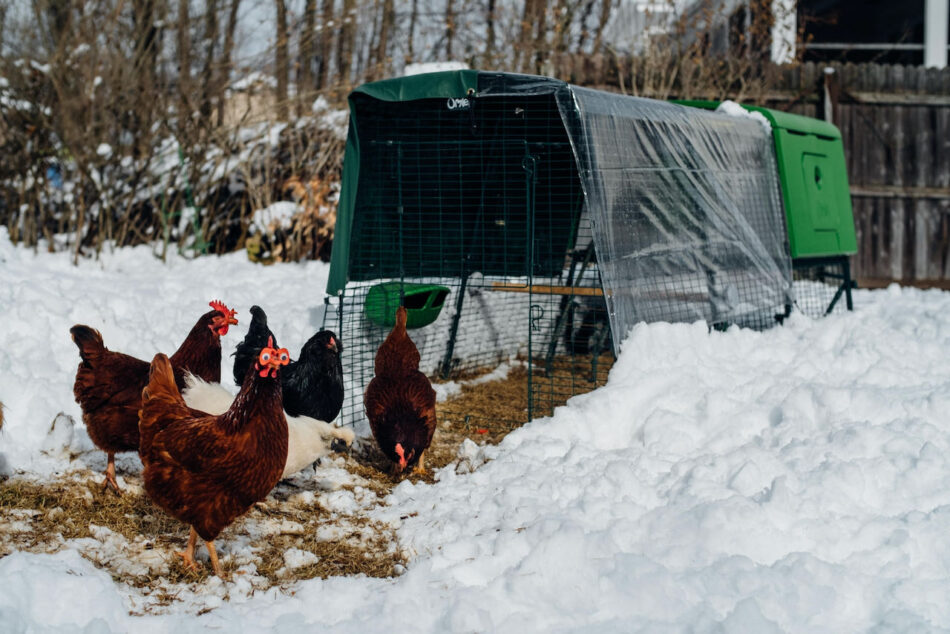
Introducing Omlet Petcare
Whether you’re a keen chicken keeper, or have a whole pack of pets, we’re here to help you take care of them. From chicken pens to roam in, to comfy dog beds your pooch will adore.
This entry was posted in Chickens
“I can build something better for less.”
As an Omlet Ambassador I’ve heard that line hundreds of times at trade shows and expo halls all across the United States. However, as a former DIY luxury chicken coop builder and longtime Omlet Coop owner I would like to set the record straight and explain why on Omlet Coop is the best purchase a backyard chicken tender can make.
This was my pride and joy:

A luxury coop that is Pinterest worthy and constructed of the best materials I could get my hands on. It has a radiant barrier roof that I shingled! It has a skylight in the middle that is UV blocking and tinted so as to only protect against the harsh and hot Texas sun. We used metal bracing on every corner to make sure we were squared up and secure. There are hundreds of screws holding up the double layer of hardware cloth. Literally, hundreds of screws. I used pressure treated wood that was rated for ground contact and further sealed with deck sealant. I used fiber cement siding that was rated to withstand hail impact and wind thrown objects. No expense was spared in building the Fort Knox of chicken coops that I thought would last a lifetime. I even ordered special chicken shaped handles for the coop doors:
Why is an Omlet Coop a better buy than building a DIY coop?
Experience should not be underestimated when lives are on the line
- Omlet was founded in 2003 and has been innovating since. That is over 16 years of experience in building chicken coops. That is 16 years of predicting and preventing predators from getting chicken dinners. The average DIY’er that I meet at trade shows or talk to on forums such as BackYardChickens.com is a first-time chicken owner who hasn’t witnessed the creativity and determination of predator animals such as raccoons, foxes, and even neighborhood dogs.
- Included in the price of each and every Omlet coop is 16 years of research and development to give us chicken tenders the best possible home for our flocks. That is 16 years of perfecting the Omlet Coops that get delivered to front doors all across the World. I cannot emphasize this enough because it is the most important factor in why I chose Omlet over DIY’ing another coop. It is not 16 years of making the same old coop over and over again like you’ll find at Tractor Supply or the local hardware/feed store. It is 16 years of constant innovation and stalwart dedication to making the safest coop on the market. While you read the rest of this please ask yourself whether you think a few google searches, a Facebook group, or in my case a Pinterest post can compete with 16 years of on the ground experience with thousands of models sold and tested across not just the US but the world at large. Think about the chickens you will soon be bringing home to live in the coop. Do you trust their lives to a weekend DIY project? Also, if you have kids and they are involved with the chickens then please consider the trauma of them waking up some day to find that a raccoon has turned their favorite hens into a recreation of a CSI episode with a headless hen as the victim. The cost may be steeper up front, but I can personally assure you that it will be more than worth it in the end for the peace of mind, the portability, the cleanliness, and so many other reasons.
- DIY may seem like the cheaper route but I can assure you that the first time you wake up to find your favorite hens dismembered by a racoon or de-feathered and half eaten by a fox the last thing on your mind will be how you saved a couple bucks here and there. Why go through the heartbreak of losing hens and then spend the next couple days having to drain your wallet to renovate and repair the coop? Also, once a predator gets into your coop once they will keep coming back for more. They will poke, pull, and attempt to gain access in any way possible since they now know that an all you can eat chicken dinner is just inside. Why not stop them the first time so they never even consider coming back?
Materials
- The most commonly encountered coops on the internet are constructed of wood. Wood can either be treated or untreated. Treated wood is wood that has been infused with copper products under extreme pressure in order to give it a few extra years of protection against Mother Nature.
- However, treated wood does not protect against the ammonia rich droppings left behind by fluffy chicken butts. Chickens do not urinate and defecate separately like us humans do. Instead they combine the two acts and their droppings are highly concentrated and highly corrosive to many materials. This results in an accelerated rate of decay and decomposition of any and all wooden components of a DIY coop. This is a hugely important point to consider because decaying wood is similar to rotten wood in that it is incredibly fragile, and fragility is not something any chicken owner wants when it comes to their coop. The only way to circumvent this is to be diligent in replacing decaying panels as soon as you notice the first signs of decay. Mind you, this requires purchasing more materials, expending more of your time performing the labor to remove the decaying parts and reinstalling the new parts, and adds undue stress to your flock as you tinker with their home.
- Of note, there are various sealants and paints that can be used on both treated and untreated wood, but my firsthand experience showed that these only served to prolong the inevitable as they too decayed. Furthermore, I would caution against their use as they can become a health hazard for your flock. Chickens will eat just about anything they can fit into their beaks so as the paint and sealant begin to crack, chip, and flake off the chickens will pick at the cracking paint or sealant and will quickly eat any flakes they can knock off or catch on the ground. I am not a veterinarian, but it certainly doesn’t take one to warn against the well-known dangers of ingesting paint.
- Omlet coops are made out of a high-density plastic polymers that are non-porous and designed to be durable against both Mother Nature and any mother hen. The corrosive droppings from your chickens do not affect the durability of the Omlet coop and will not cause it to degrade or deteriorate with wood. It will stay strong for decades or more without any need to repair, replace or renovate.
- Chicken wire, I would like to just say to stay as far away from this as possible because every week I hear from people who used chicken wire only to discover their coops broken into and flock decimated. Chicken wire is good at containing chickens but is absolutely worthless for keeping predators out. Raccoons can reach their hands through it and can pull it apart in under an hour. Coyotes, foxes and neighborhood dogs can easily bite and pull it apart. Snakes slither right on in without trouble.
- The other wire that people commonly use is hardware cloth. This is what I used when I first built my own coop and it does work for a while. However, over time it will sag, and it is not meant to bear weight well. It can prevent predators most predators for a while but it is far from impenetrable and without proper installation and constant checks it can easily fail and need replacing.
- The run components are made from welded steel panels. I could go further into detail about these, but I think the picture below is worth a thousand words:

Portability
- It was a sad day when I had to leave behind the Pinterest quality barn-inspired coop because we sold the house and couldn’t haul off the coop without hiring a forklift and crew to load it onto a flatbed.
- Thankfully, that will never happen with Omlet Coops. They are portable when fully assembled and they are also so easy to disassemble and flat pack that I can now fit our multiple coops and run attachments into the bed of my pickup truck with ease. In fact, I had to do just that when we moved from Tulsa, Oklahoma to Austin, Texas.
Modular and Expandable with ease
- One of the hardest parts about designing and building a DIY coop is that you have to know how many chickens you want from the start. That may seem like an innocuous task but there is a phenomenon known to chicken owners as “chicken math.” It is something I have encountered first hand and been a victim of. In what started with 3 chickens has now since expanded to 31 chickens and counting. Our barn inspired chicken coop was meant to house 5-6 hens at a time and any sort of expansion would be extremely costly and require cutting into, and compromising the structural integrity of the original coop to attach any expansions on it.
- Our Omlet coop expanded with us and we are already saving up for another full-size WALK-IN-RUN to add. Attaching any sort of expansion or add on is literally a 10-minute job. Due to the modular structure of the Coop and the Walk-in-Run all that has to be done is clip on the new expansions to the existing ones.
Cost
- The total cost of the Pinterest coop that I build was around $1600. It fit 5 chickens comfortably and held up for just short of 2 years before we started to have to replace parts and deal with decay.
- Chicken coops from Tractor Supply range from $250 to over $1,000. However, most of these have wooden components that will break down and need replacing so you will have to throw money at it regularly to keep it functional.
- There are a handful of plastic polymer options at TSC but none of them allow for attaching a run, or any sort of modular upgrades that will allow you to grow your flock or custom tailor your coop to your yard. Therefore, you will end up spending well over the cost of an Omlet coop for something that is not designed to fit together and is not as adaptable and flexible as a product from Omlet’s ecosystem.
Peace of mind knowing all of the “What if’s” have been accounted for.
- As stated above, Omlet has more experience in this field than any DIY’er. They have answered all of the if, and, buts, and what ifs with first hand experience. The peace of mind that comes with being able to purchase an all in one coop that will last for decades, keep the flock safe, and be adaptable to your future needs is worth more than saving a few bucks by risking all of that.
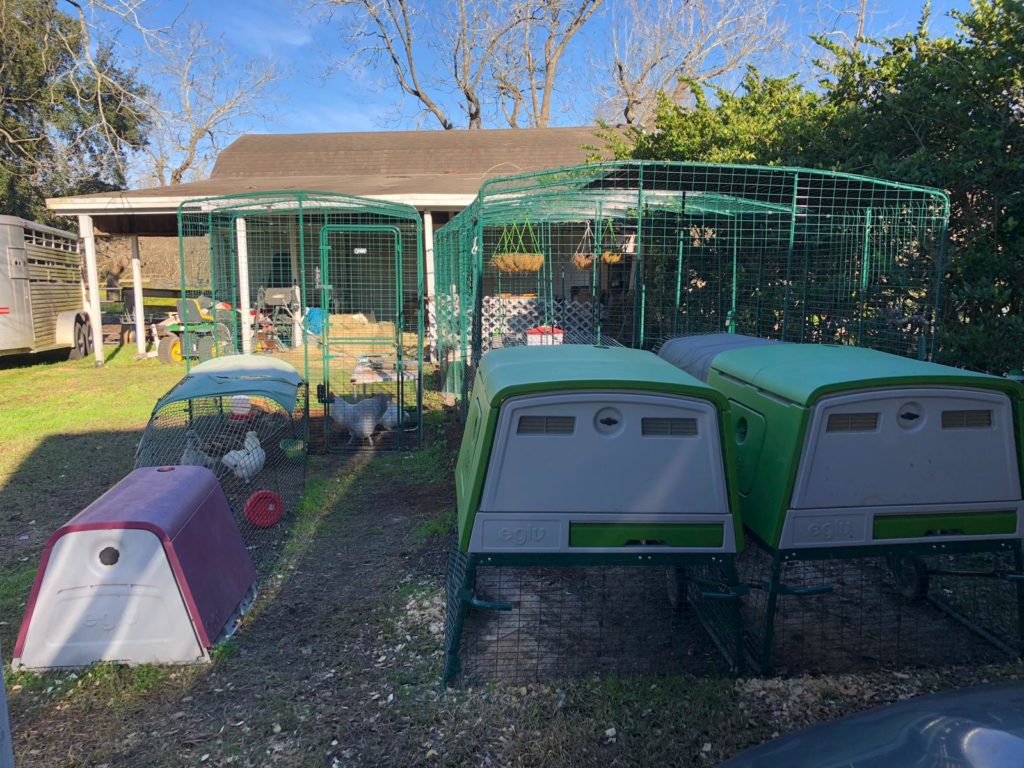
This entry was posted in Chickens
Using a steam cleaner to clean any Eglu can be a very effective way. It will not affect the plastic, whereas all surfaces are cleaned, disinfected, and all killed mites, insects and dust are blown away by the power of the steam. As a bonus the surfaces will be dry in no time, because the plastic is warmed up.

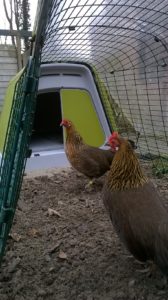
Deep-cleaning an Eglu Go once or twice a year is extra easy if one follows these steps:
1. Take of the top panel (lid)
2. Unscrew both side panels and bumpers, and take these off as well. For a complete cleaning you may want to disconnect the run as well.
3. You now have access to all inner and outer surfaces. Clean them thoroughly with the steam cleaner, if required using an old dish brush as well.
4. Clean the bumpers, panels and top lid in the same way.
5. Re-assemble the run and the coop.
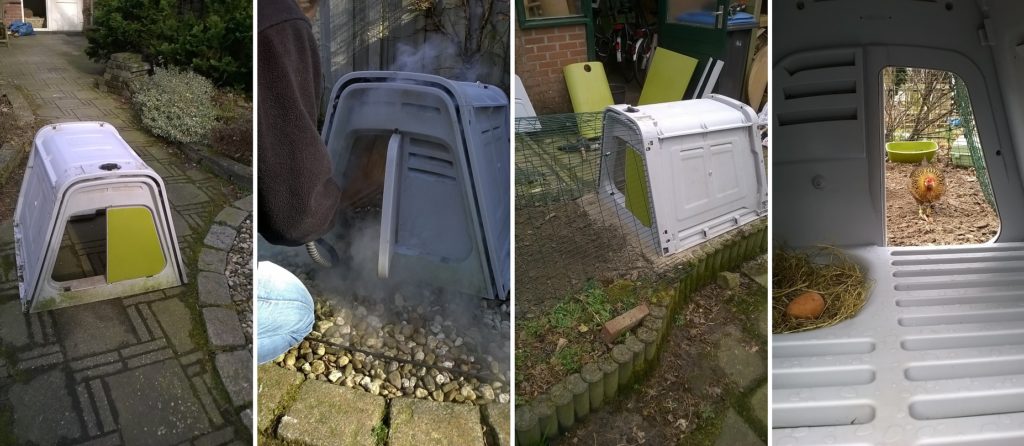
This cleaning method has been used for several years now by our Dutch team-member and is guaranteed to keep your Eglu in a top condition, without damaging any parts!
This entry was posted in Chickens
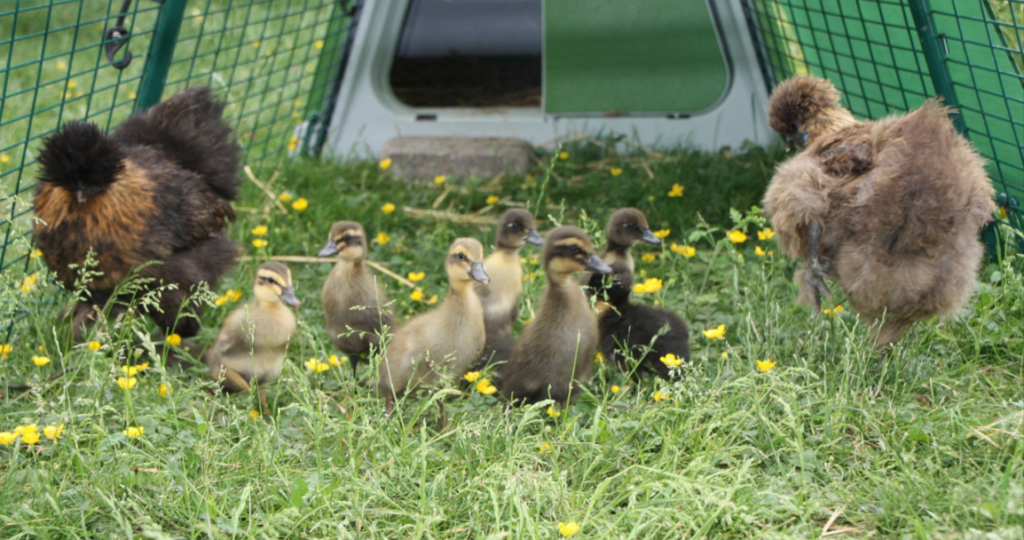
By Lotte Denckert
I’ve been lucky enough to be allowed to test the Omlet Eglu Go. Over the spring and summer I’ve first had a brood of chicks and later a brood of ducklings living in my Eglu Go.
The house is awesome to use as a broody coop and for raising chicks. The house is easy to clean, has good draught-free ventilation, it has a good size for chicks and ducklings, and the attached run gives great protection for the little ones early on, when they are very exposed in relation to birds of prey and other unwelcome guests.
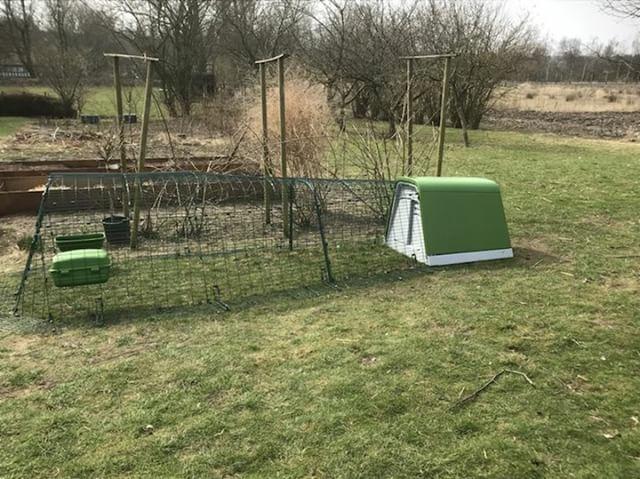
Eglu Go for raising chicks
At first, my chicks were living in a cage in our guest room. They were hatched using an incubator and needed a chick brooder in the first few months as it was very cold outside. When the temperatures started to rise and the chicks had more well developed feathers, I moved them out into the coop. I kept them here for about 10 weeks. There were 10 chicks and they fitted easily in the coop until they were large enough to move into the large chicken coop with the grown-ups. I removed the roosting bars in the coop since small chicks don’t sleep on roosting bars in the beginning. I filled the coop with a generous layer of wood shavings and straw since it was still cold in the spring.
The coop is pretty easy to move around, especially if you add the wheels. You can therefore move the coop and run when the grass starts to get dull, this way, the chicks always have fresh grass to walk around on.
It’s great to have a closed run for the first while. Small chicks are exposed to birds of prey – this run keeps the birds from attacking. My grown hens were also a danger to the chicks in the beginning. Chickens aren’t always hospitable when it comes to new members of the flock. The small chicks could be left in peace in their run and the big hens could slowly get used to their presence. This made it so much easier to introduce them later, since they were already used to each other.

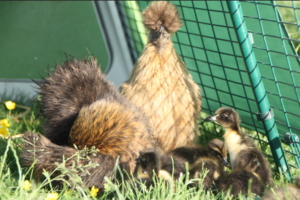
Hatching and rearing in the Eglu Go
When the chicks were too large to all live in the coop, I introduced them to the large flock, and then I suddenly had an empty Eglu Go. My ducks had laid a lot of eggs in a large nest but none of them were interesting in brooding. I already had two broody silkies, so I tried putting the duck eggs under them. The chickens weren’t discriminative about the eggs, and they happily lay brooding.. About a week before the eggs were supposed to start hatching, I moved the two hens and their eggs into the empty Eglu Go. The hens were very good about it and continued their persistent brooding, a week later 8 large ducklings came into the world.
Again, I had removed the roosting bars from the coop since ducks don’t sleep on roosting bars. This way, there was also room for two nests. The hens got along fine and they didn’t seem to mind that their babies had webbed feet rather than chicken feet.
Again, the other poultry in the garden could slowly get used to the new arrivals, and for that reason, there were also no issues when, a few weeks later, I let the ducklings and their mothers out to join the others in the garden.
The benefit of having ducks in an Eglu Go is that ducks often prefer to sleep outside. At night I let them into the run attached to the Eglu Go and close the run door so they are protected from predators. At the same time, they can decide for themselves whether to sleep in the coop or out in the run. In the morning I open the run door, so they can run freely in the garden and collect slugs, snails and insects.
I can definitely recommend this coop both for chicks and ducklings, whether hatched naturally or in an incubator. It’s a good idea to choose the 3 meter run, since it gives the little ones more space to play and explore.
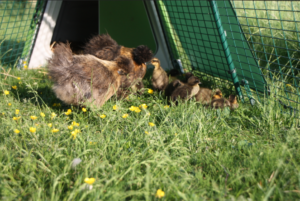
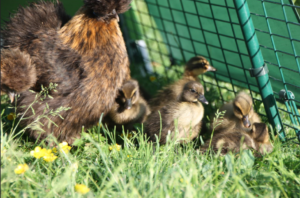
This entry was posted in Chickens
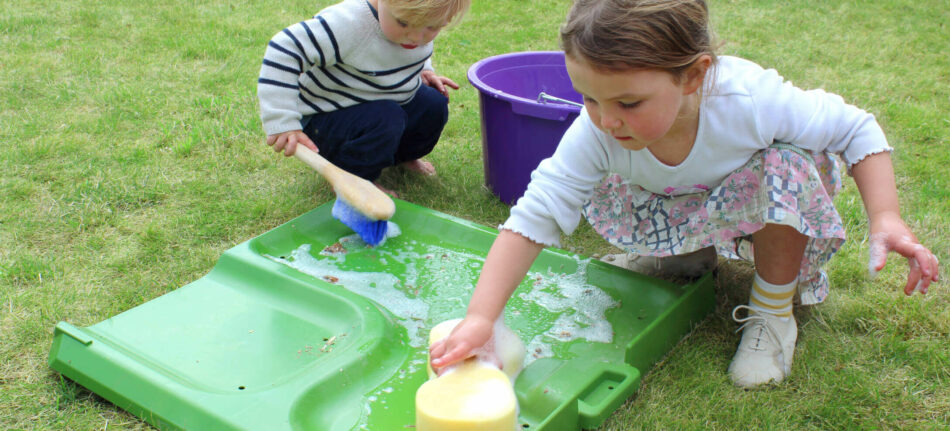
A familiar problem for both backyard chicken keepers and commercial farms lies in how to prevent and treat infestations of the birds’ environment with red (poultry) mites – also known as dermanyssus gallinae. Compared to other poultry parasites such as fowl ticks, lice and flies – mites are by far the most common, destructive and difficult to remove. Red mites are nocturnal parasites and hide themselves in gaps and cracks during the day, laying wait to wreak havoc on your flock at night.
Signs and diagnosis
Red mites are up to 1mm in size. The title “red” has been given to these mites because they turn from gray to red after they have had a blood meal. Infected hens will not be the picture of chicken health. Once the infestation becomes significant, your chickens will become anemic. Their wattles and the combs will appear pale and their egg production will drop significantly. Red mites also cause:
- Skin irritation
- Feather pecking
- Weight loss
- Restlessness in the flock
Your chickens will also probably be reluctant to go into their coop at night because that’s where the mites are lying in wait.
When checking your chicken coop for red mites, be sure to also check their perches or other chicken coop and run accessories. An easy way to check for red mites is by rubbing a white paper towel underneath the perches at night. If there are red mites, they will be on the underside of the perch after feeding on your chickens – you’ll see red streaks on your paper towel after coming into contact with them.
Prevention
An ounce of prevention is worth a pound of cure. But, when it comes to red mites, that’s sometimes easier said than done. Wild birds or new chickens can transmit red mites to your flock. Check your chickens’ health regularly to make sure all flock members are feeling their best.
It’s also a good idea to check for red mites routinely when you clean your chicken coop and use some preventative measures. Diatomaceous earth as part of the weekly clean is helpful in preventing and killing mites (DE is a 100% natural powder which dehydrates parasites it comes into contact with). All types of chicken coops can get red mites – however wooden coops tend to experience the most infestations.
Unfortunately, red mites can survive for up to 10 months in an empty hen house, so leaving a coop empty for a while doesn’t usually fix the problem. Choosing your housing carefully can help prevent infestations Omlet’s Eglu chicken coops are made from plastic which makes it very difficult for red mites to make a home. And in the event that there is a red mite infestation, they are quick and easy to clean. A quick blast with a pressure washer will be enough to send the mites packing.
6 Ways to treat red mites
1. Cleaning
If you find lots of red mites in the coop, it’s time for a deep clean. This type of cleaning will take several hours with a wooden chicken coop, but significantly less time with a plastic chicken coop. Remove all hens from the coop and strip it down as much as possible. Clean each part individually and allow for the coop and parts to dry completely.
2. Mite disinfectant detergent
Mix a mite disinfectant detergent (such as Smite Professional Disinfectant 1L Concentrate or Barrier Red Mite X 500ml Concentrate) with water (using the manufacturer’s guidelines). Apply this to the coop, ensuring you get it in the cracks and crevices. Omlet’s Eglu chicken coops don’t have these awkward and accommodating spaces, making red mites much easier to control. Concentrate your efforts where there is the highest population of red mites. Leave for 15-20 minutes.
3. High-pressure hose
Use a hose (preferably a pressure washer) to hose down the coop and the parts. Try to get in every nook and cranny, as this is where the mites like to hide. Leave for 10-15 minutes to dry. After this, you will most probably see more agitated mites crawling out. Repeat this process until there are very few mites emerging after each wash. Eglu chicken coops are made of heavy-duty plastic and are designed to be pressure washed with ease. One pressure wash will be enough to eradicate any existing mite population.
4. UV
Leave the coop to thoroughly dry. It’s ideal to perform coop cleanings on a sunny day where UV rays can kill some of the bacteria. Put the coop back together and add bedding. Dispose of the old bedding in a plastic bag in the garbage – red mites will happily find somewhere else to live if given the opportunity.
5. Red mite powder
Sprinkle your entire coop and your chickens with a red mite powder. Ensure you rub the powder onto the perches so that any remaining mites will have to crawl through it to reach your chickens.
6. Repeat red mite powder treatment
Re-apply the red mite powder every couple of days or when it has rubbed off. Red mites are primarily active during mild weather, making peak seasons the spring and fall. They will lie dormant throughout the rest of the year, waiting for their next opportunity to emerge.
Preventing red mites with Omlet
Any chicken coop can fall victim to red mites, but with any easy-to-clean plastic chicken coop, you’ll be able to nip infestations in the bud. Our chicken perches can be removed easily for a thorough cleaning, and our plastic Chicken Swing offers a mite-resistant place to find relief. Don’t fall prey to red mites – take control with Omlet’s chicken products.
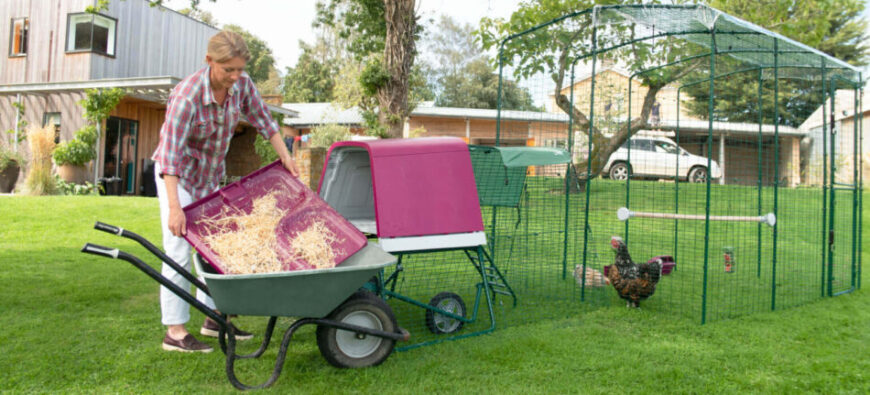
This entry was posted in Chickens
 Christmas is coming and with it the dreaded Christmas shopping! To make life easier this year for you we are offering FREE DELIVERY ANYWHERE in Australia when you buy the Eglu Go Chicken Coop or Eglu Go Hutch (more…)
Christmas is coming and with it the dreaded Christmas shopping! To make life easier this year for you we are offering FREE DELIVERY ANYWHERE in Australia when you buy the Eglu Go Chicken Coop or Eglu Go Hutch (more…)
This entry was posted in Chickens
If you want to collect your order rather than have it delivered you can. Here’s how you do it and some of the commonly asked questions:
1. Decide what you want to order (we’d suggest one of everything!! :))
2. The DAY BEFORE you want to pick up your order, order online or call 02 81034124
3. The day AFTER your order, call the warehouse on 02 8882 5400 to confirm what time between 8am and 3:30pm (Monday to Friday) you will collect your order. Take your order number with you and go to:
ACR Supply Partners
12 Distribution Drive
Orchard Hills
NSW 2748
Frequently Asked Questions:
- Can I collect my order on the weekend?
No sorry, the warehouse is only open Monday to Friday 8am to 4pm. - It’s a long weekend are you open on the public holidays?
No sorry. - What happens if I am running late, do I need to call and tell Omlet?
The warehouse is a third party that we use, it isn’t owned by Omlet, sometimes they are there later than 4pm, but we cannot guarantee it. It is up to you if you still go or if you go another day, you don’t need to let us know. - Can I see any of the Omlet products assembled at the warehouse?
No sorry, it is literally just a warehouse with boxes of products in it. - Can I pay at the warehouse?
No sorry, there is NO Omlet office at the warehouse and therefore no one to take payment. - Will someone call or email to tell me that my order is ready for collection?
Yes, we will email you to let you know you can pick it up. If for some reason it has been a few days and you haven’t collected your order we will probably give you a call to check that you didn’t select collection by mistake. - When I order online it wants my address why is that?
You do need to put in your address when you order online even if you are picking it up so that we can check your credit card against your address. - Can I send someone else to collect my order?
Yes of course, just make sure they have your name and order number. - Will my order fit in my car?
It is best to check on the page of the item you are ordering, at the bottom of the page it will tell you the box dimensions so that you can work out if it will fit. - Do I have to lift the boxes into my car?
Usually the warehouse guys will help you, unless they are very busy.
This entry was posted in Chickens
























 Unfortunately, bullying amongst chickens happens, and isn’t actually too uncommon of a problem. Chickens naturally create a pecking order, whereby the flock will establish themselves in a social hierarchy of strongest to weakest chicken. However, if aggressive behaviour continues after the head rooster, or the dominant hen in their absence, has found their way to the top of the ladder, you may be dealing with a bully. Common signs are missing feathers from a chicken’s back, unusual weight loss, reduced egg production, or blood from where the victim has been pecked, all of which could lead to a chicken/s refusing to go into their coop at night.
Unfortunately, bullying amongst chickens happens, and isn’t actually too uncommon of a problem. Chickens naturally create a pecking order, whereby the flock will establish themselves in a social hierarchy of strongest to weakest chicken. However, if aggressive behaviour continues after the head rooster, or the dominant hen in their absence, has found their way to the top of the ladder, you may be dealing with a bully. Common signs are missing feathers from a chicken’s back, unusual weight loss, reduced egg production, or blood from where the victim has been pecked, all of which could lead to a chicken/s refusing to go into their coop at night. The metal chicken runs are designed to be used outdoors for years to come. However, we recommend that you check the run regularly for signs of corrosion, especially if you live somewhere with extreme weather conditions or close to the sea. Corrosion will occur if the coating has been scratched or scraped for example. If you do see some, remove any loose rust and touch up with a weather resistant paint.
The metal chicken runs are designed to be used outdoors for years to come. However, we recommend that you check the run regularly for signs of corrosion, especially if you live somewhere with extreme weather conditions or close to the sea. Corrosion will occur if the coating has been scratched or scraped for example. If you do see some, remove any loose rust and touch up with a weather resistant paint.

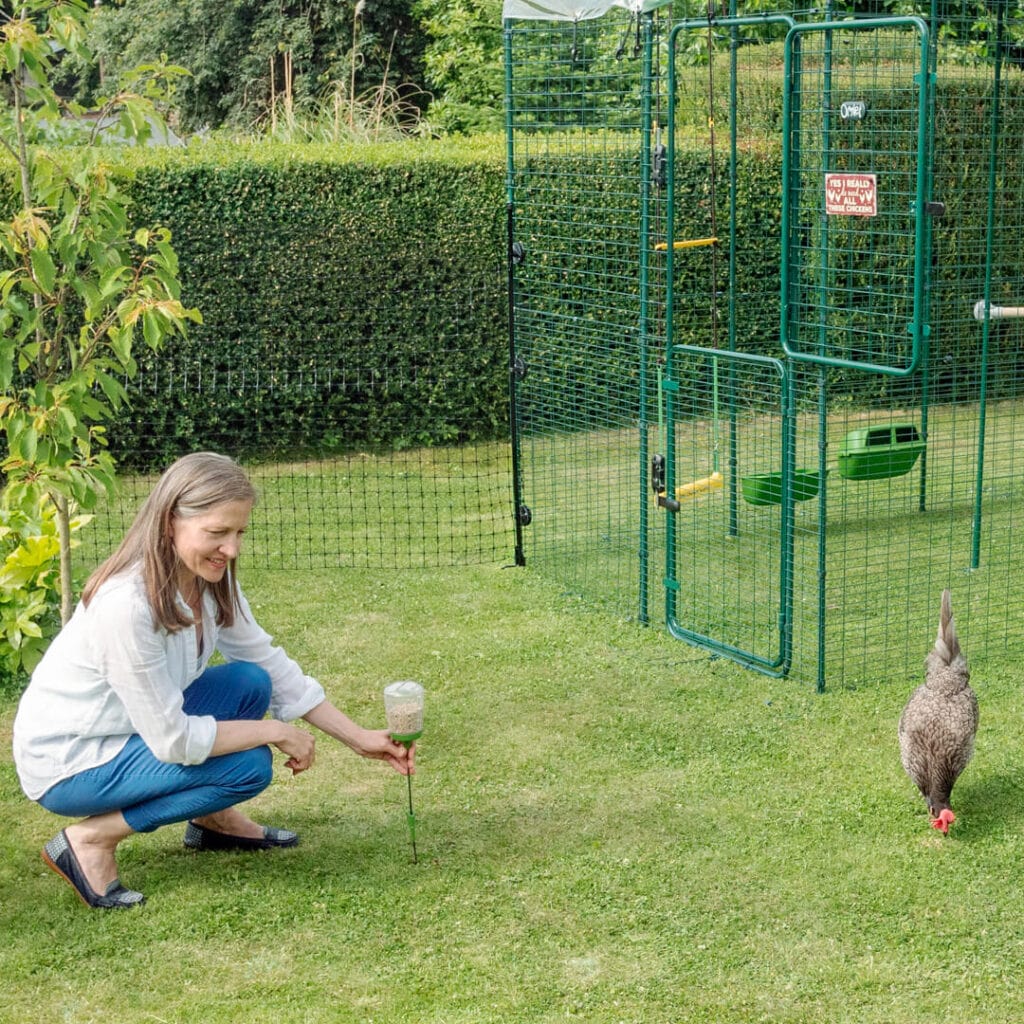
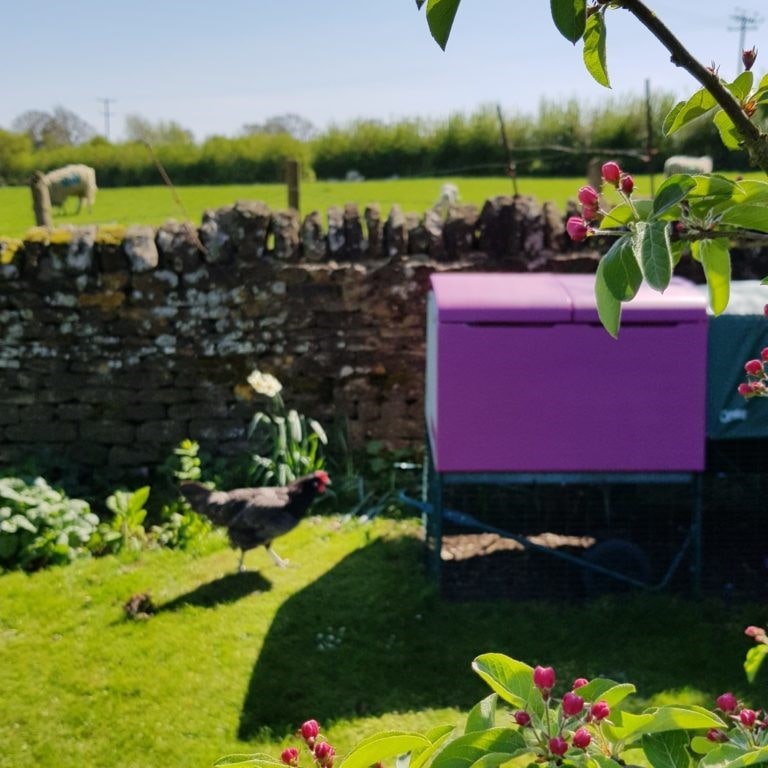
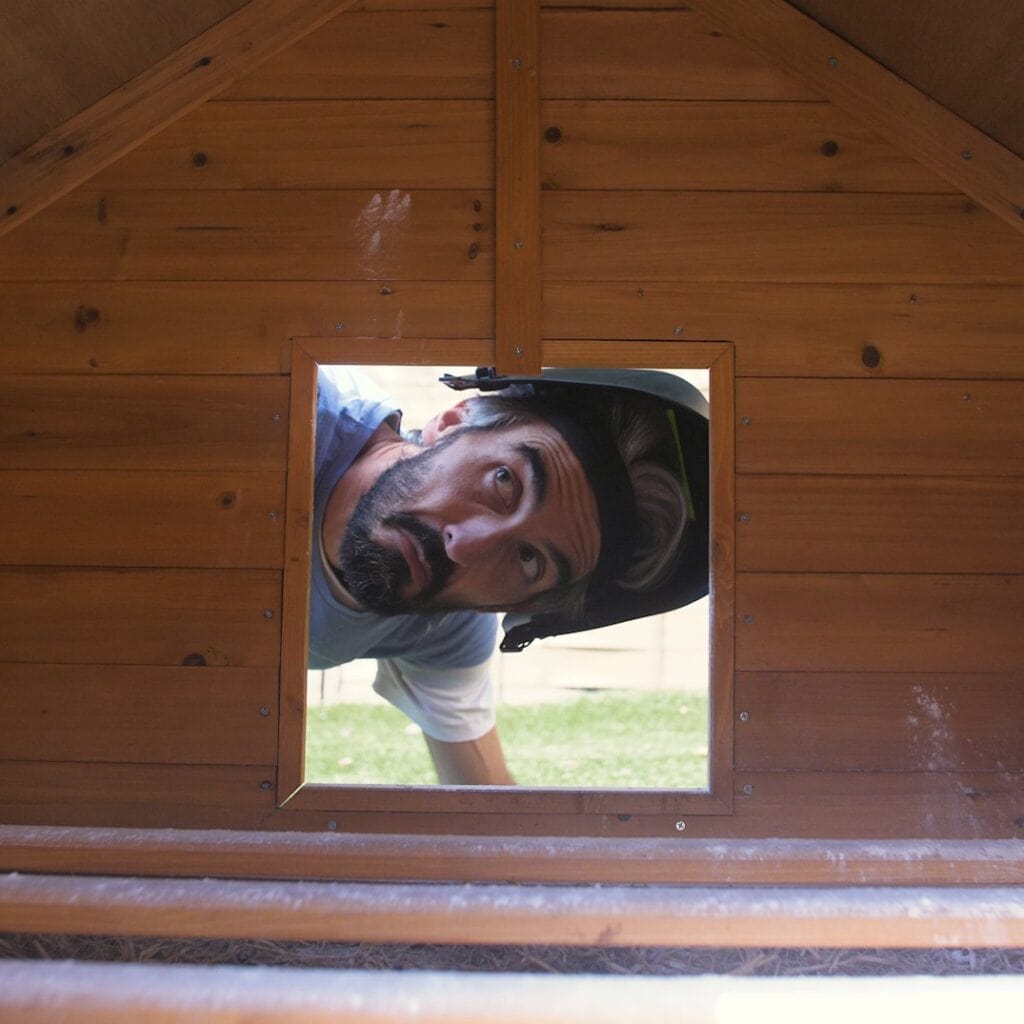
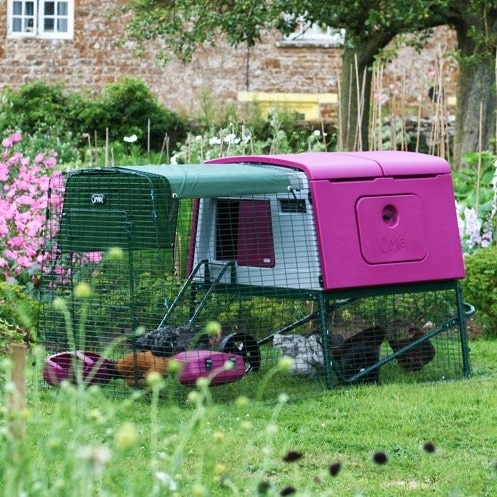




















 Christmas is coming and with it the dreaded Christmas shopping! To make life easier this year for you we are offering FREE DELIVERY ANYWHERE in Australia when you buy the
Christmas is coming and with it the dreaded Christmas shopping! To make life easier this year for you we are offering FREE DELIVERY ANYWHERE in Australia when you buy the